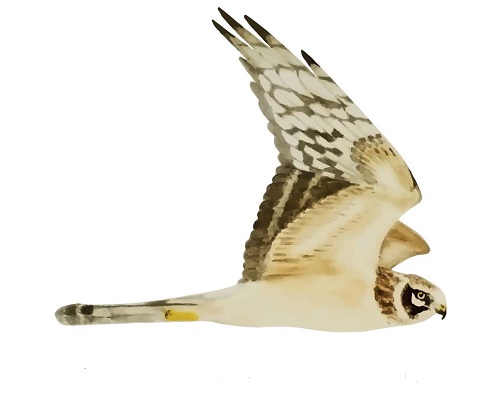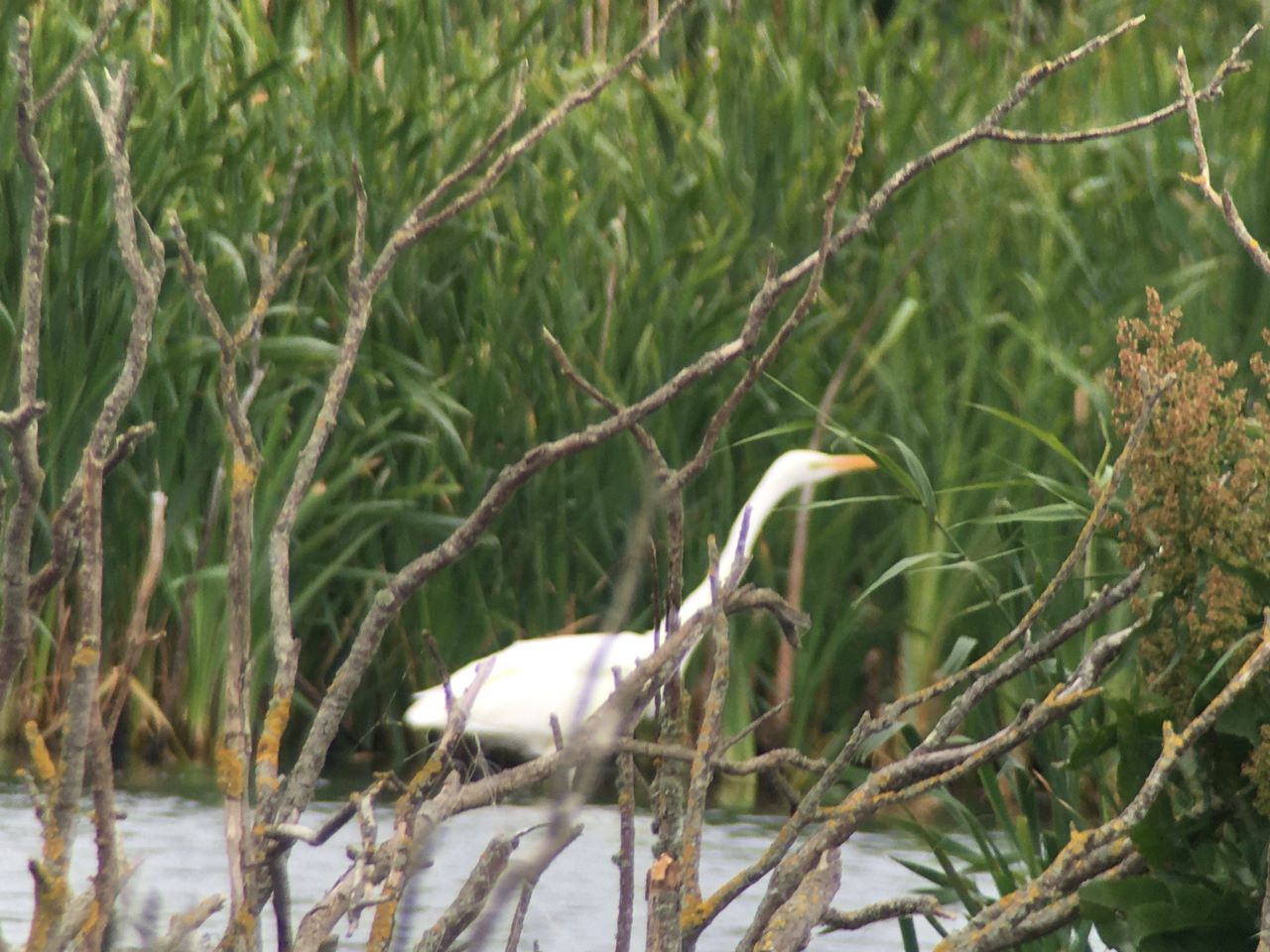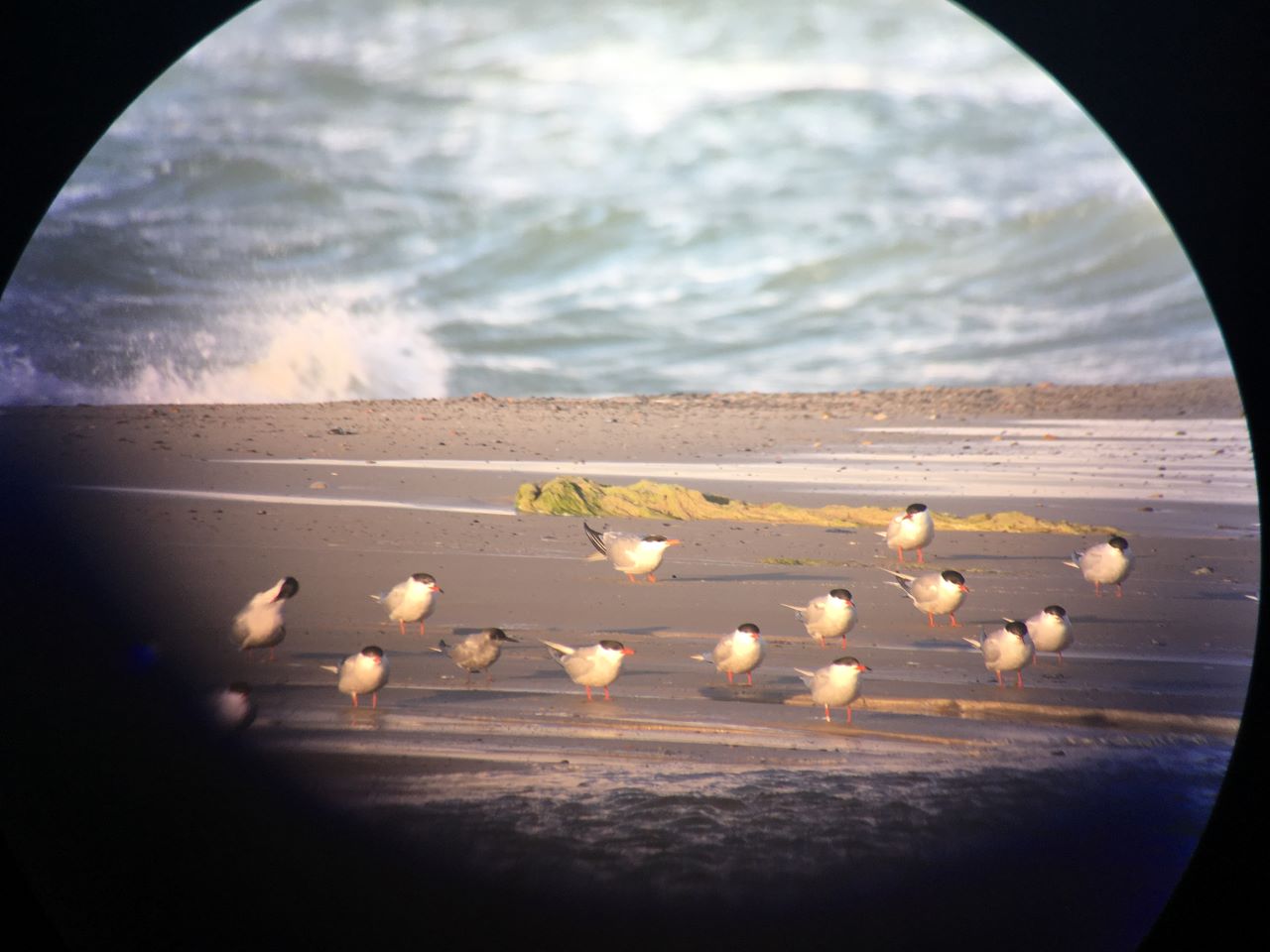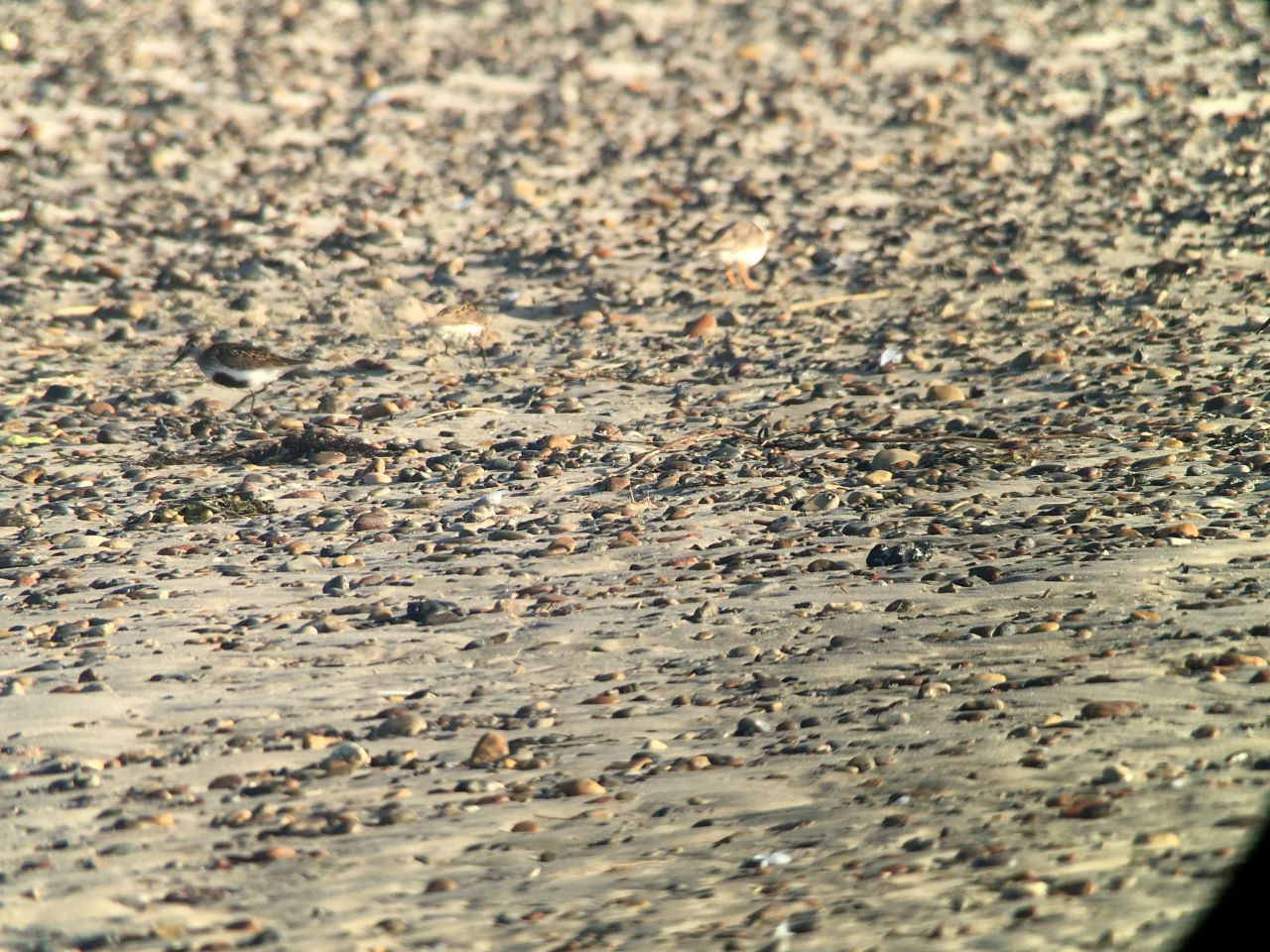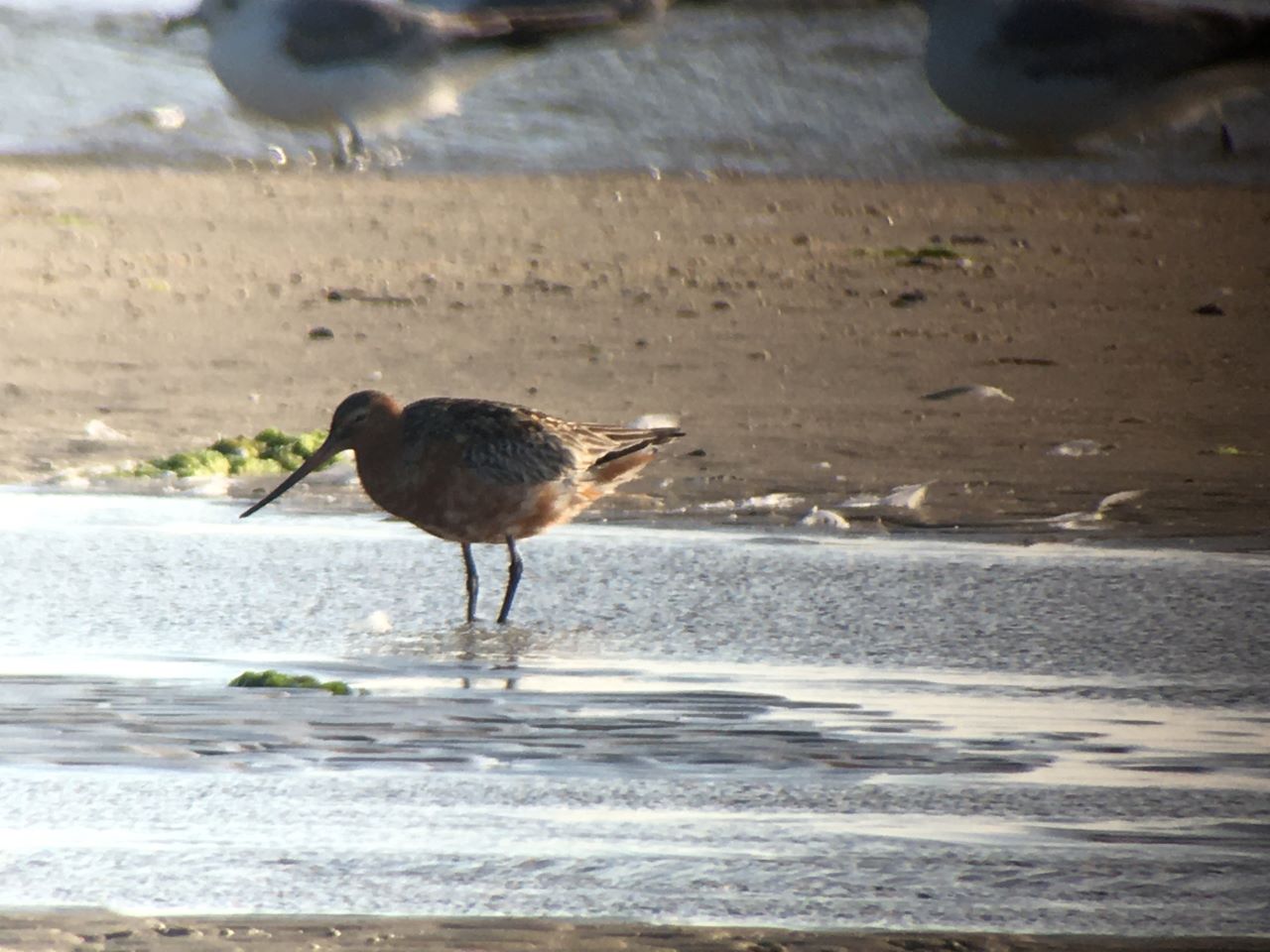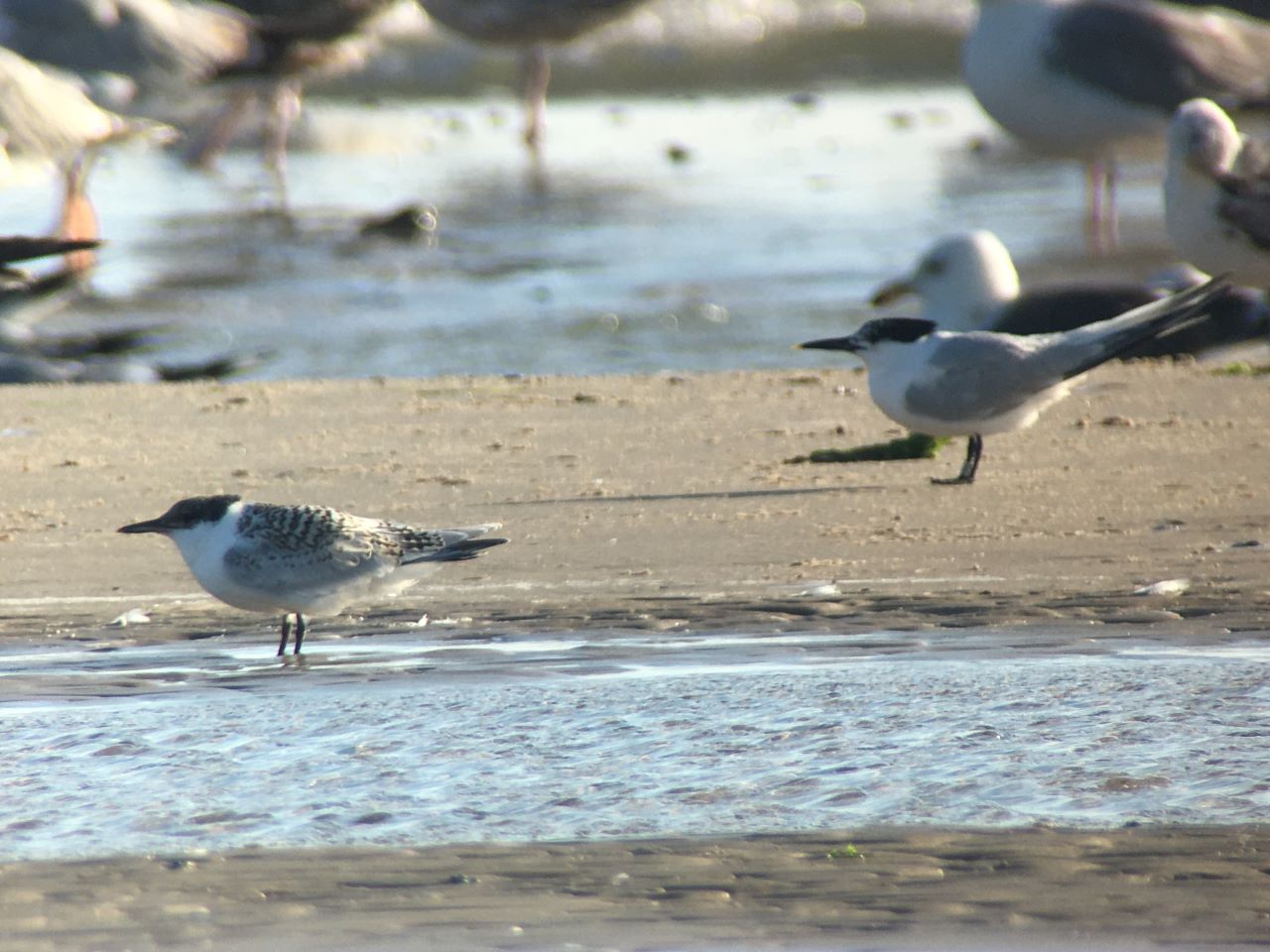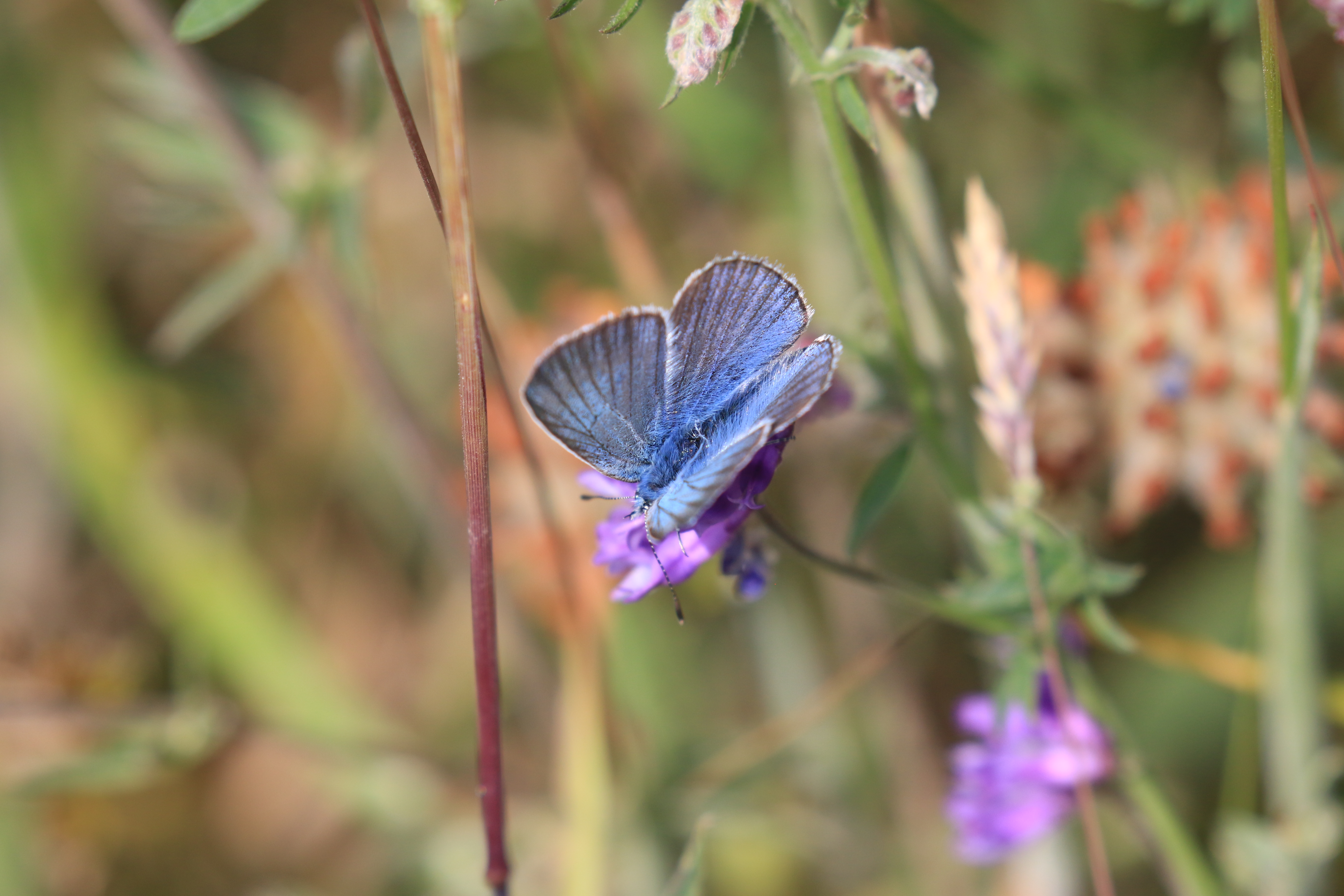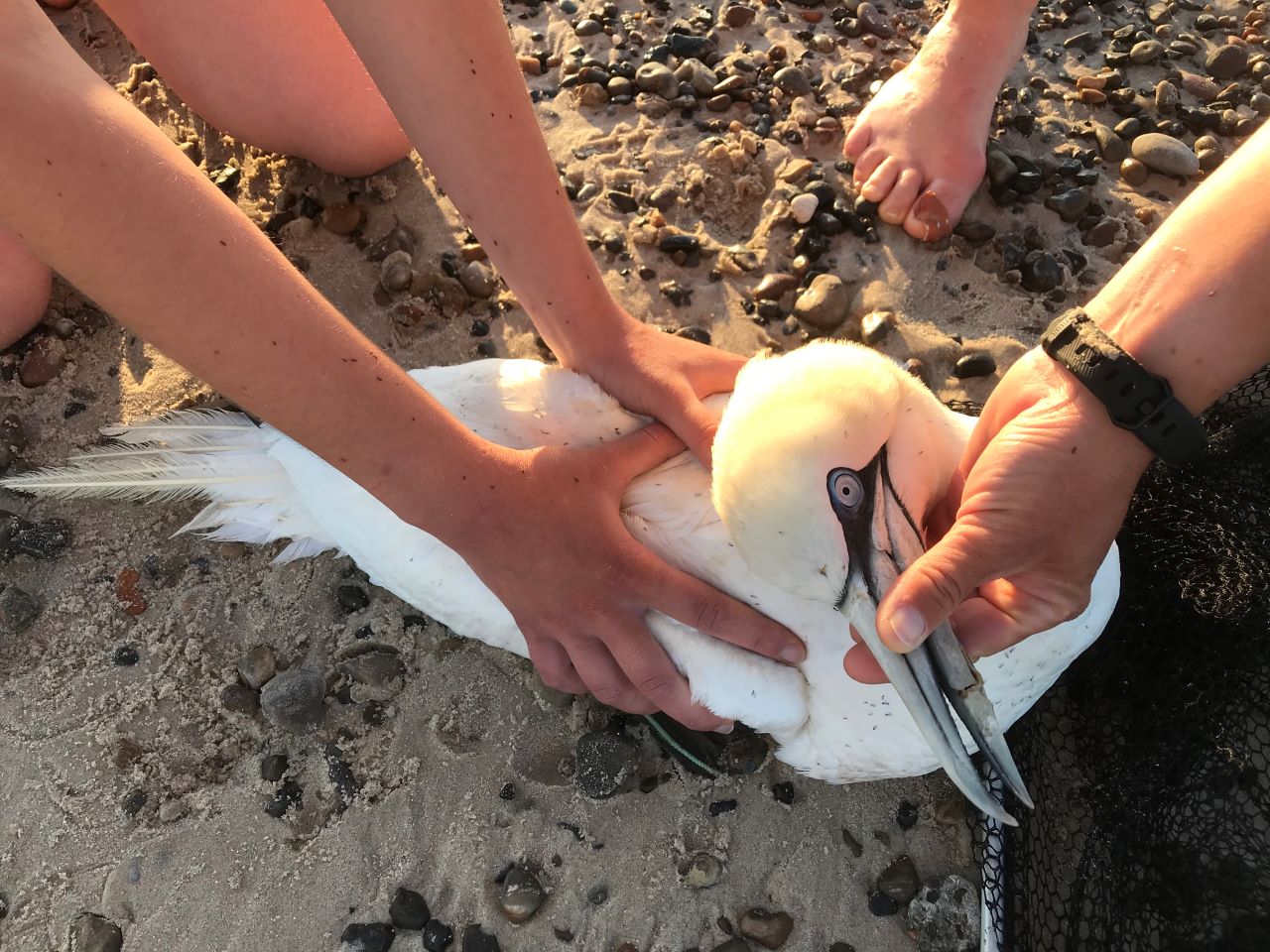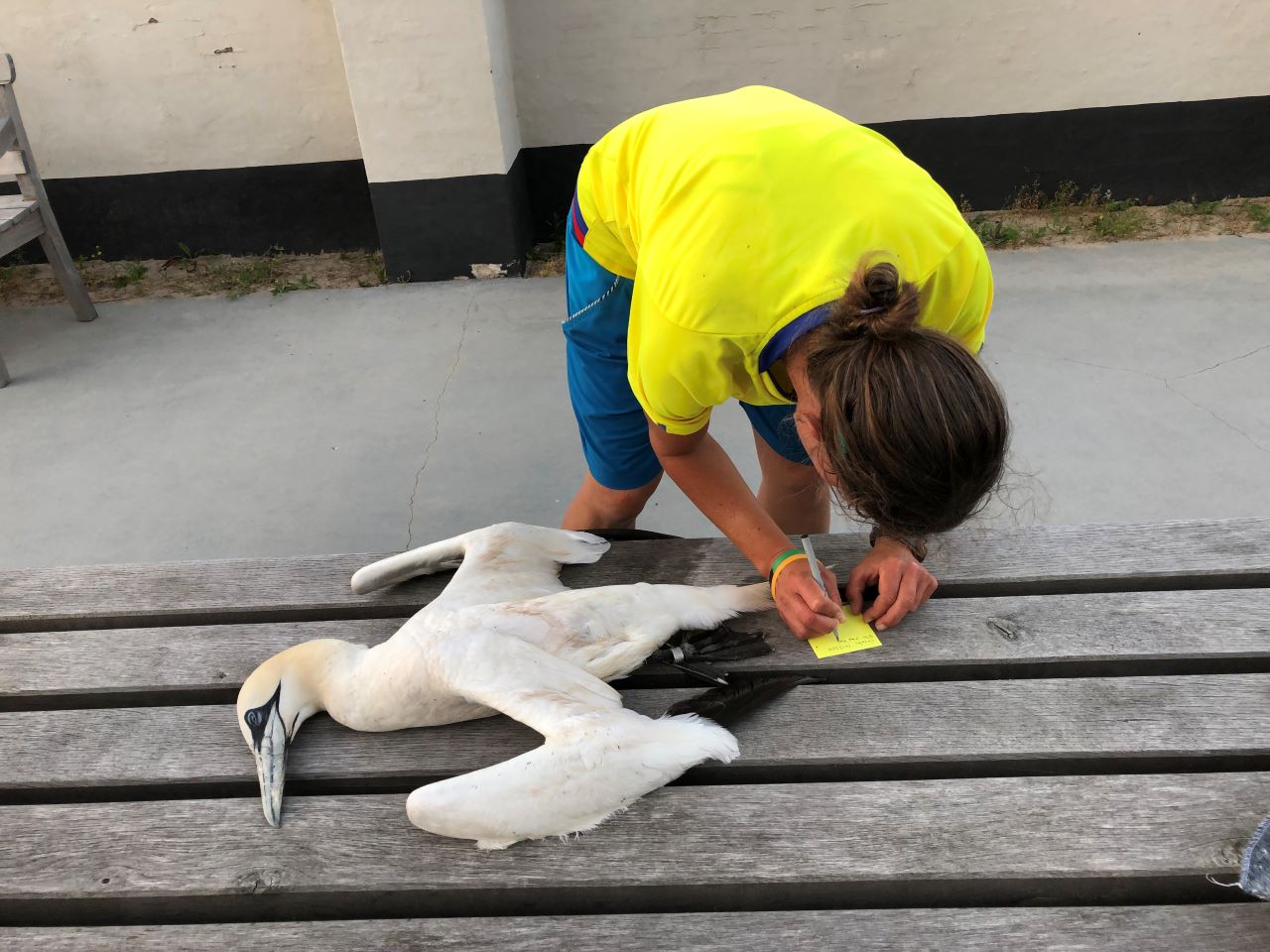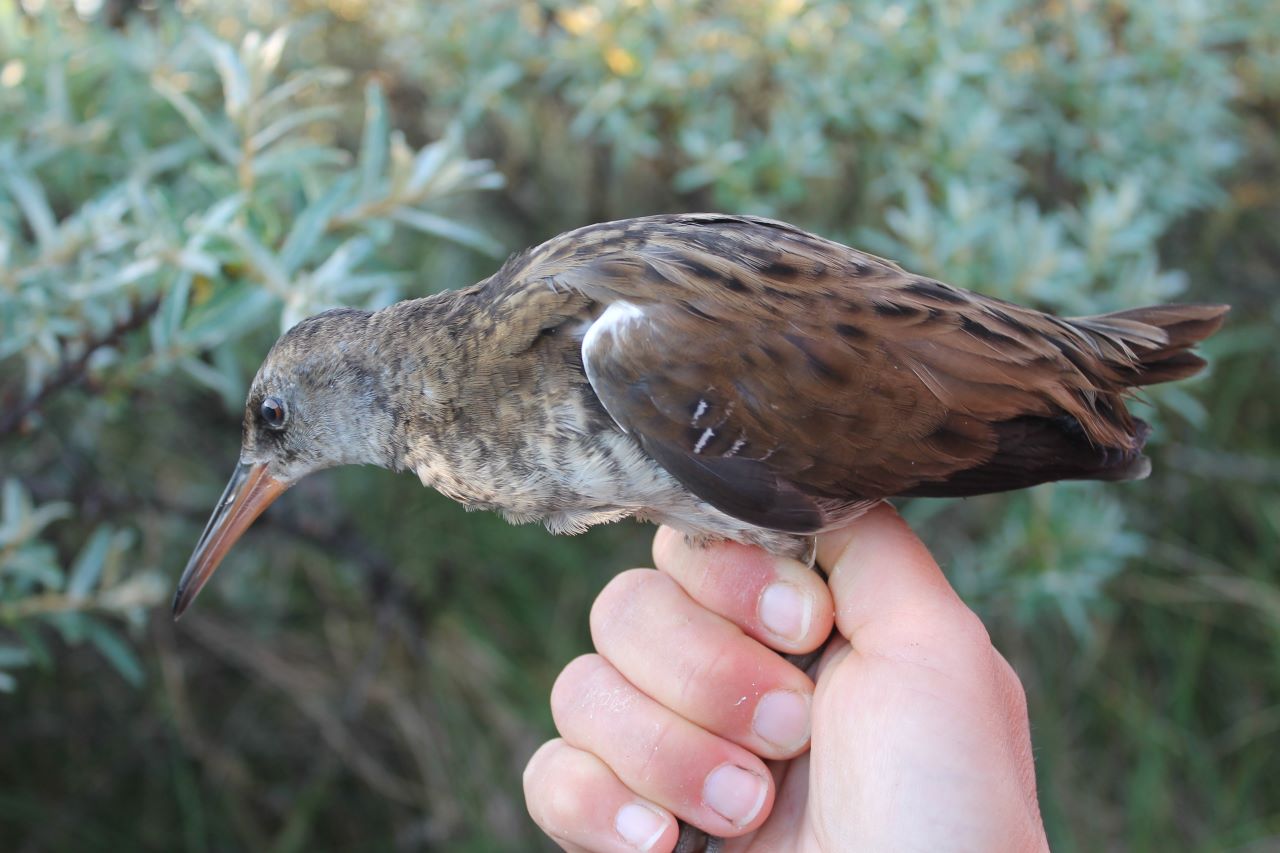Her på Skagen Fuglestations blog bringes korte nyheder i dagbogsformat om hændelser på fuglestationen.
…Og så så vi en sølvhejre!
Når man kan lide at kigge på fugle, så ved man, at det kræver en stor portion tålmodighed og en del held. Ofte ser man det, man kommer efter - og næsten lige så ofte er fuglen fløjet, eller den har gemt sig, når man kommer.
Som amatørfugleelskere er vi på aktiv ferie på Skagen Fuglestation. Vi får lov til at være med i felten og på sidelinjen når der tælles og mærkes fugle. Det er en virkelig dejlig og lærerig måde at holde ferie på. I dag var ingen undtagelse…
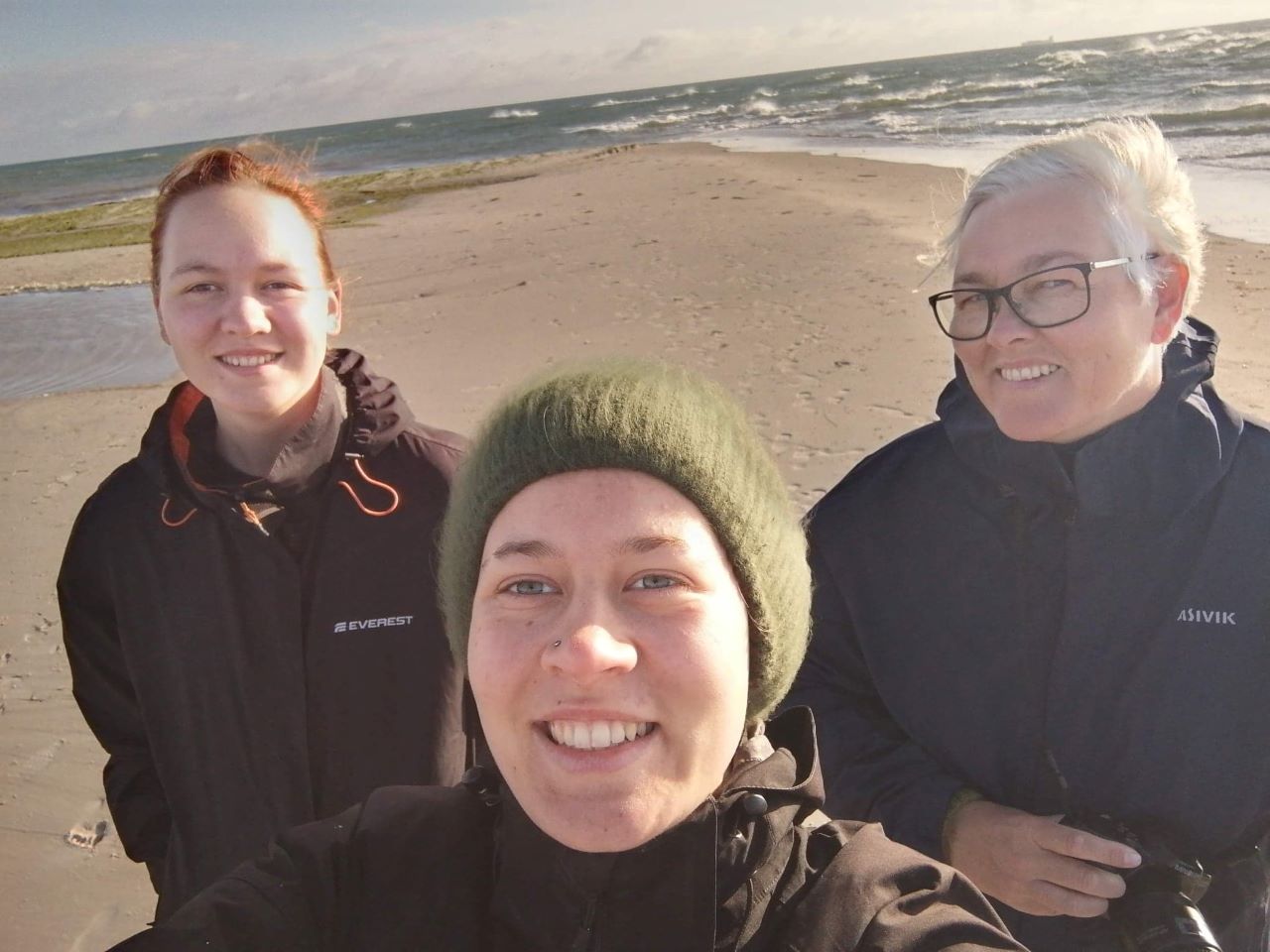
Vi tog til Jennes Sø for at se fuglene blive ringmærkede. Vi skulle både kigge på fuglene og lave optagelser til en video til Skagen Fuglestations instagram/Facebook (tjek den ud!). Efter at have kigget nærmere på en solsort, en gransanger og en tornsanger gik vi videre med Amandine til skarvkolonien. Hun skulle tælle ungerne i rederne. Og så så vi den… Sølvhejren! Når man aldrig har set sådan en før, så føler man virkelig, at man har fået jackpot i fuglelotteriet. Virkelig smuk var den, som den stod der og lyste hvidt i baggrunden af den næsten dystopisk mørke skarvkoloni, og det blev ikke mindre kontrastfuldt af de truende, mørke skyer over os. Virkelig en god oplevelse.
Til sidst tog vi til Nordstranden for at finde stor præstekrave. Vi ville også gerne have fundet nogle reder, men vi så kun nogle enkelte fugle pile afsted i vandkanten og søge føde. Men som sagt, når du leder efter fugle så har du brug for held - og selvfølgelig viden om, hvor og hvordan de lever. Da vi forlod Nordstranden kom Amandine og Martina (aka de professionelle frivillige) og de fandt selvfølgelig stor præstekrave og reder med æg.
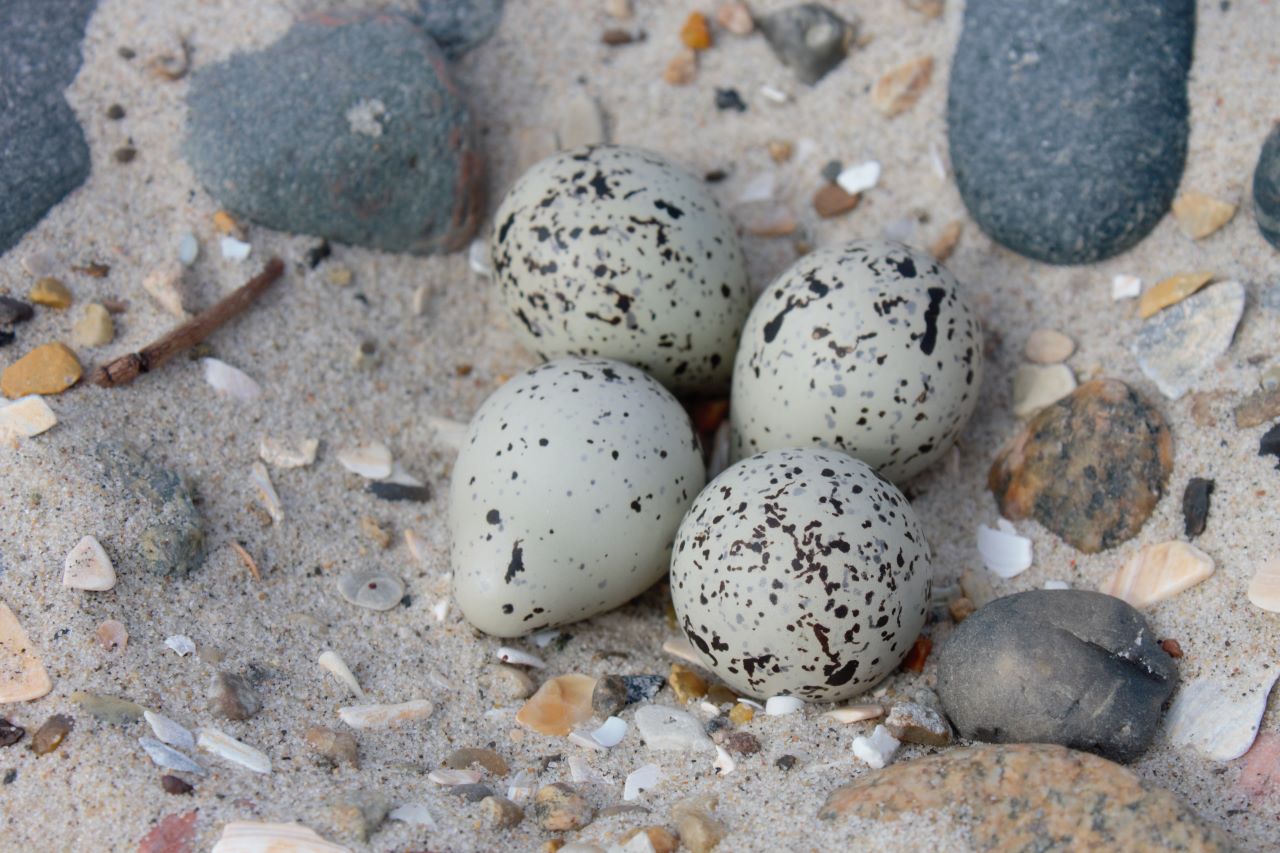
Hvis nogen for nyligt har set rovdyr (f.eks. ræv) ved kolonien hører vi gerne om det! Så vi kan komme nærmere et svar på hvad som har taget ungerne. Hold oså gerne øje hvis du ligger vejen forbi den næste tid og lad os vide hvis der sker noget.
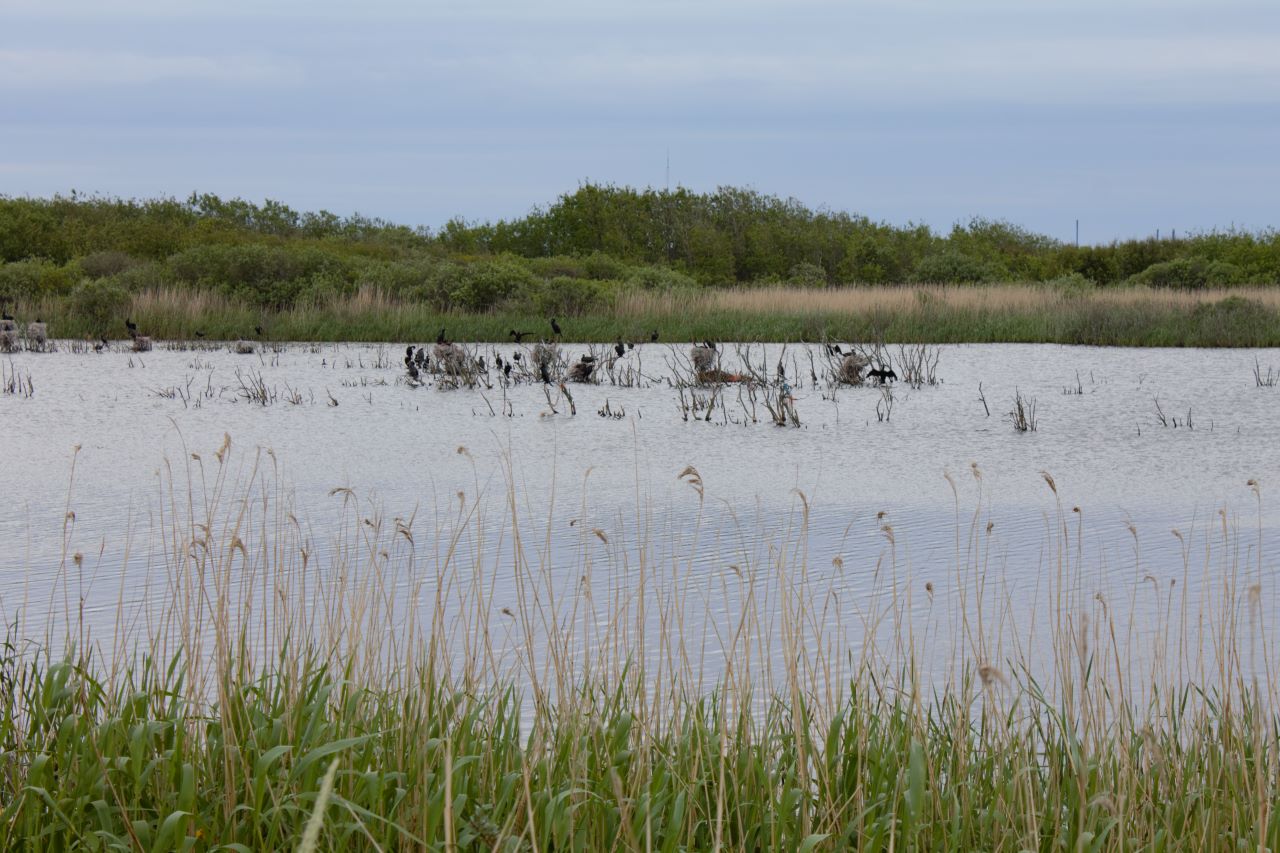
Vinden har godt fat i Skagen for tiden og man kan godt blive sulten af al den blæst, så vi besluttede at ende dagens fugleeventyr her, og tage ned til byen og få en god frokost.
Ringmærkning (Jennes Sø):
Gransanger – Chiffchaff - 2
Topmejse – Crested Tit – 1
Rødhals – Robin - 1
Tornsanger – Common Whitethroat – 1
Total: 5
Folk: Martina Hillbrand, Simon S. Christiansen, and Amandine Doré
Klik her for at se dagens observationer indtastet i Dofbasen af observatører i området
A long day and night at Kabeltromlen
Yesterday evening, we went ringing at Kabeltromlen, hoping to catch waders thanks to the new nets we set up in the reeds. Winds were still quite strong, but we surprisingly caught some birds, more than we expected. Almost all of them were recaptures, only two of them were new birds. And unfortunately, no wader were caught, even though we flushed a Common Snipe (Dobbeltbekkasin) several times.
During the ringing, I went down to Grenen beach, close to the tip, to check the Sandwich Terns (Splitterne) and count them. None of them were roosting, they were actively fishing and therefore I could not count them. However, I enjoyed very much seeing them diving in the water and catching some fish. It’s always very impressive !
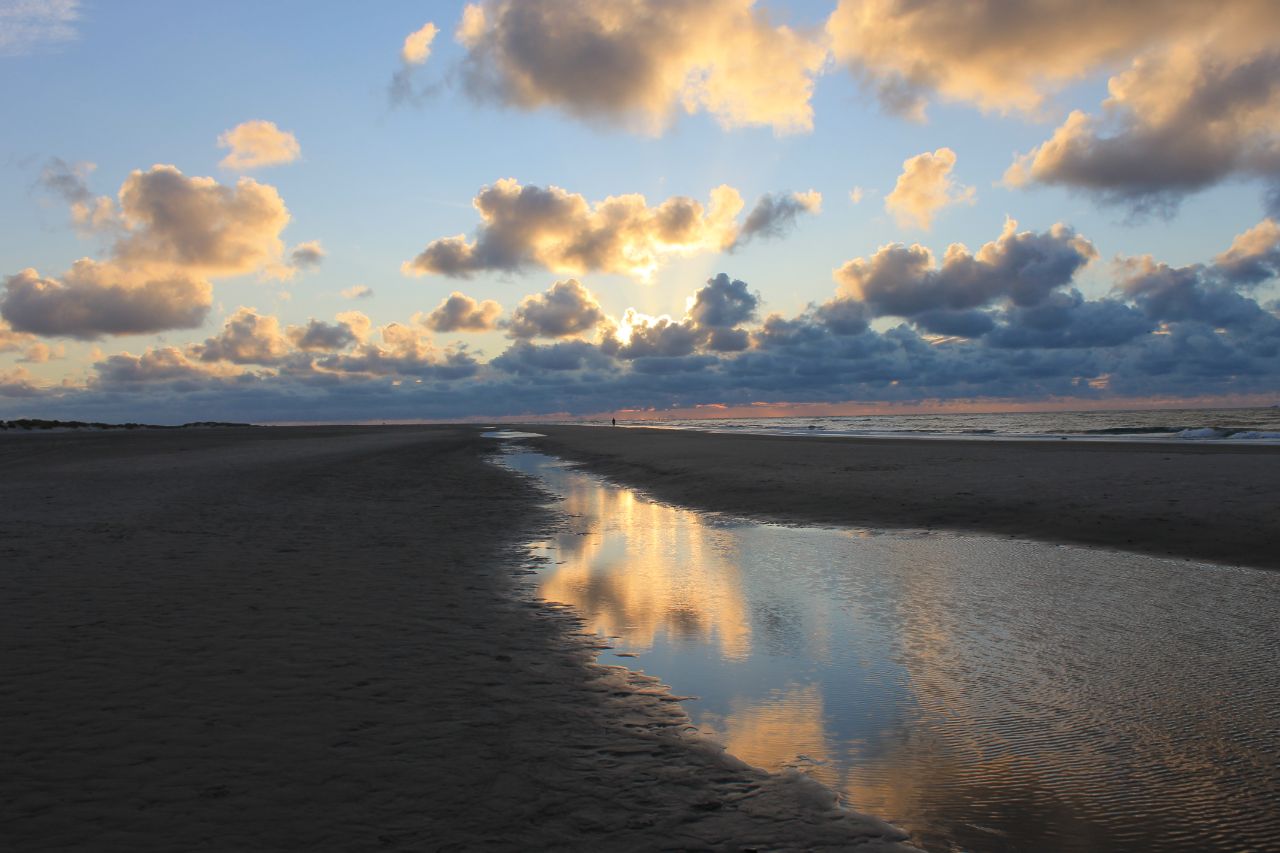
Sunset at Grenen tip
Moreover, the seals were at the Grenen tip, hadn’t seen them since I arrived, and I had been looking forward to see them. They were amazing !
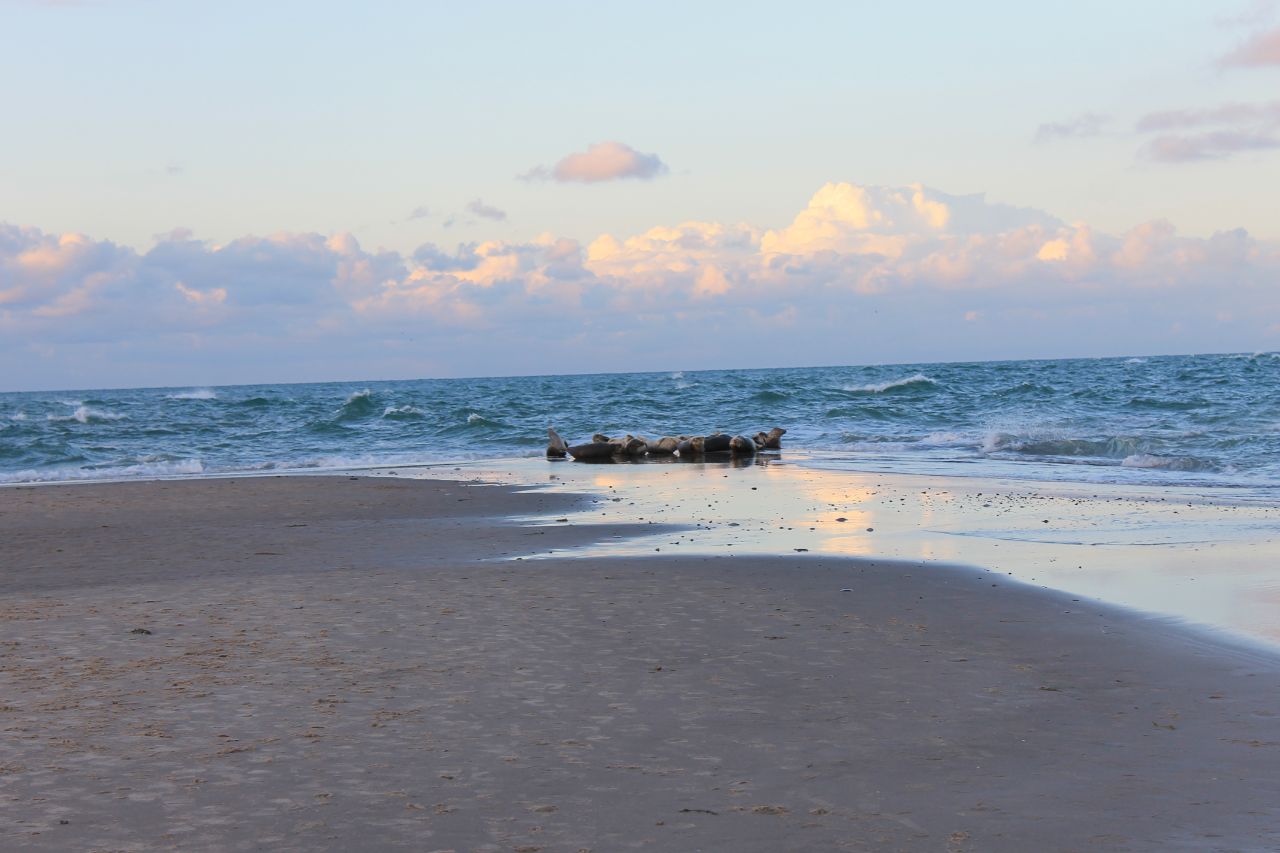
Seals
We closed the nets around 22:00 and went back home, to get some sleep before the morning ringing.
Martina went opening the wader nets at 2:30am, as it is more likely to catch them during the dark hours of the night. I joined at 3:15am to open the rest of the nets, and we carried on our normal ringing. Again, we got another Blackcap (Munk) “wave” and we really wonder where they all come from. We thought that by now we had probably ringed all the Blackcaps of Skagen, if not Denmark !
And today was also a very special “Munk day”, because we caught our first juvenile Blackcap ! Finally !
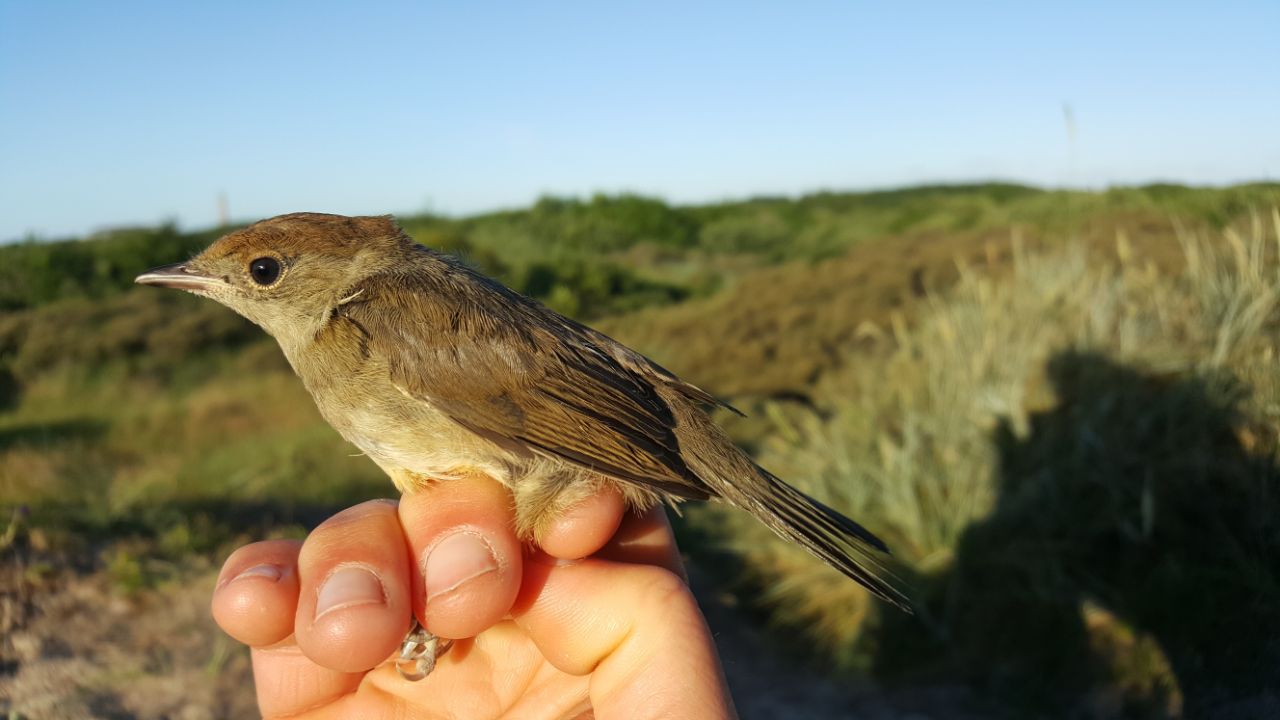
Juvenile Blackcap (munk)
The winds were not slowing down in the morning, even getting stronger and we decided to close the nets early, at 6:45am. In the last net checks, we caught two beautiful Bullfinches (Dompap Lille), one male and one female.
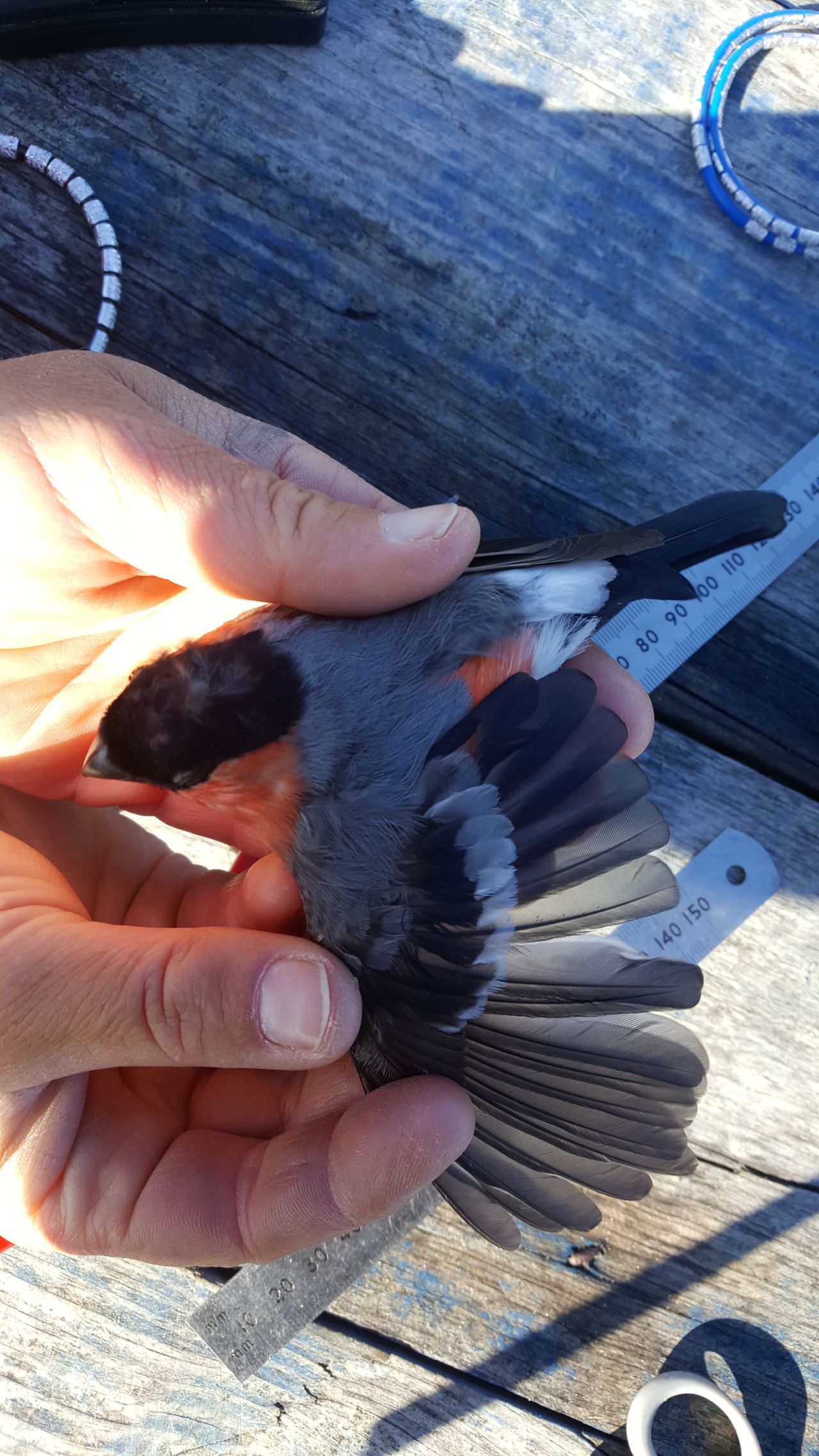 Male Bullfinch (Dompap Lille)
Male Bullfinch (Dompap Lille)
We went back home and got some sleep after this long night/morning, before pursuing our daily office tasks. We then later went to set up nets for the CES ringing that we will do tomorrow.
Ringmærkning (Kabeltromlen) - 01/07/2020:
Common Whitethroat - Tornsanger - 1
Chiffchaff - Gransanger - 1
Total: 2
Ringmærkning (Kabeltromlen) - 02/07/2020:
Great tit - Musvit - 1
Marsh Warbler - Kærsanger - 1
Lesser Whitethroat - Gærdesanger - 2
Garden Warbler - Havesanger - 2
Blackcap - Munk - 7
Common Whitethroat - Tornsanger - 2
Chiffchaff - Gransanger - 3
Total: 20
People : Martina Hillbrand, Simon S. Christiansen, Amandine Doré
Klik her for at se dagens observationer indtastet i Dofbasen af observatører i området
Tern Day
We did not go ringing again this morning since it was still very windy, however, instead we went again to count the terns and look for ringed Sandwich terns (splitterne). It was a very windy, however, also very beautiful morning. The storm from last night had moved quite a lot of sand so the beach looked very different from what we were used to and the water is still very high. Compared to yesterday there were almost no gulls which made it easier to get closer to the terns and also find some shorebirds around.
The black tern (sortterne) I saw last night was not seen again, however, we saw 3 dunlins (almindelig ryle) and 1 bar-tailed godwit (lille kobbersneppe).
We also counted 40 sandwich terns and for the first time there were 2 juveniles from this year in the flock as well. Next to that again around 20 common terns. And that was only the roosting birds: many more were out fishing!
We saw some ringed terns but unfortunately no color rings and we could not get close enough to read the metal rings. We will try again tomorrow.
In the afternoon Karsten Hansen came to interview Simon about the work of Skagen Fuglestation. We opened the nets in the lighthouse garden despite the strong winds but the birds weren’t moving so until the very end we didn’t catch anything. Just when we thought we would have to disappoint the camera team we had a single whitethroat (tornsanger) in the last net check. For us a common bird, I am sure it made the TV team very happy. And it was a good way to show one of the most important parts of the work we do here.
In the evening we will go out ringing at Kabeltromeln, partly because we miss the ringing, partly because the winds are supposed to continue for a while and this evening is probably the best few hours of the week to catch birds. Also we set up a wader net and since waders are starting to move south now we are hoping to catch something cool there. We will report tomorrow.
Frederik left today for good. Or at least until next year. If the number of reported rarities from Skagen suddenly goes down then you know why. We were very happy to have him both to help with identifying birds in flight and with the Danish names of the birds. Now Amandine and I are alone with Simon until the new volunteers for the autumn arrive. We will do our best to continue the great work on raptor counts that Frederik started.
Talking about raptors: Thom Kongerslev was so nice and sent us his beautiful pictures of the long-legged buzzards (ørnevåge) he saw in the last few days in Skagen. The pictures show that it was two different birds, which is quite interesting for such a rare species.
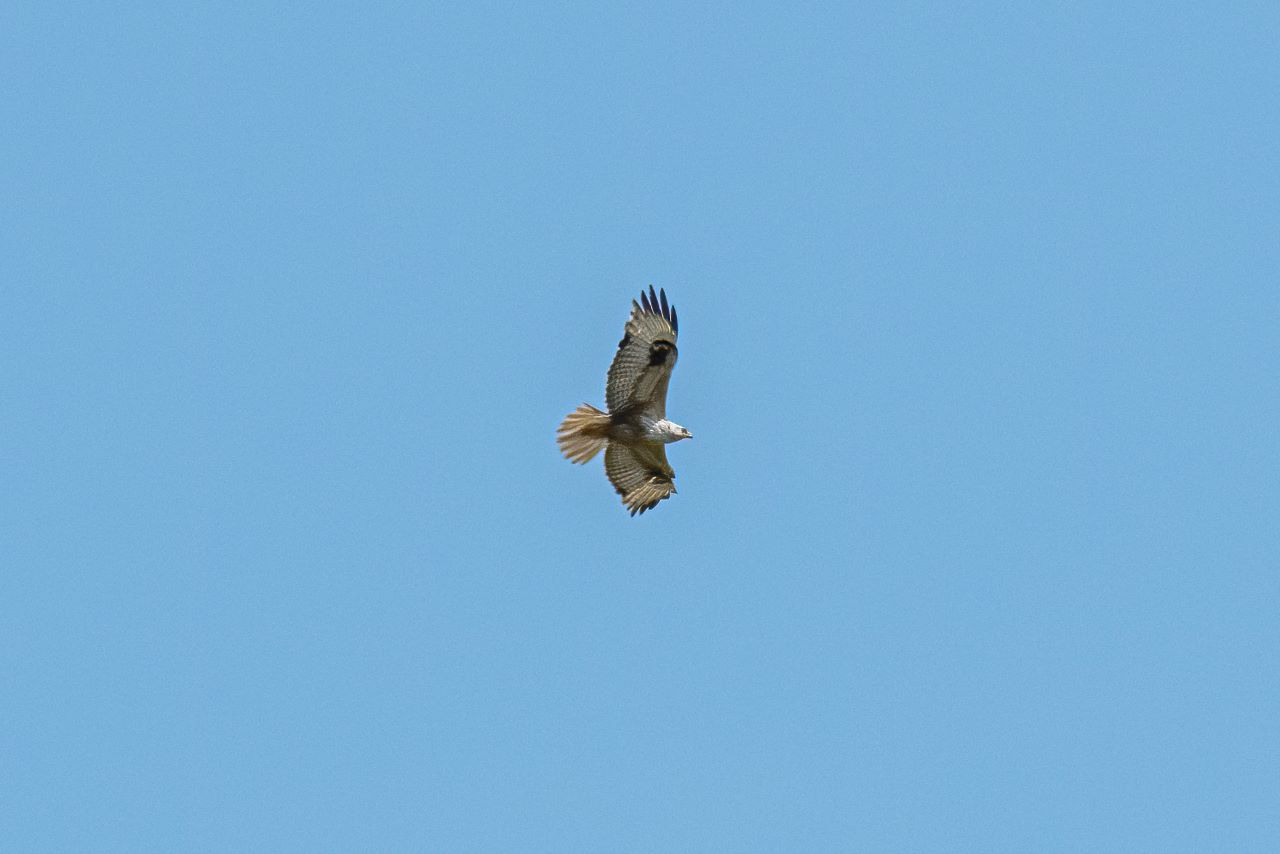
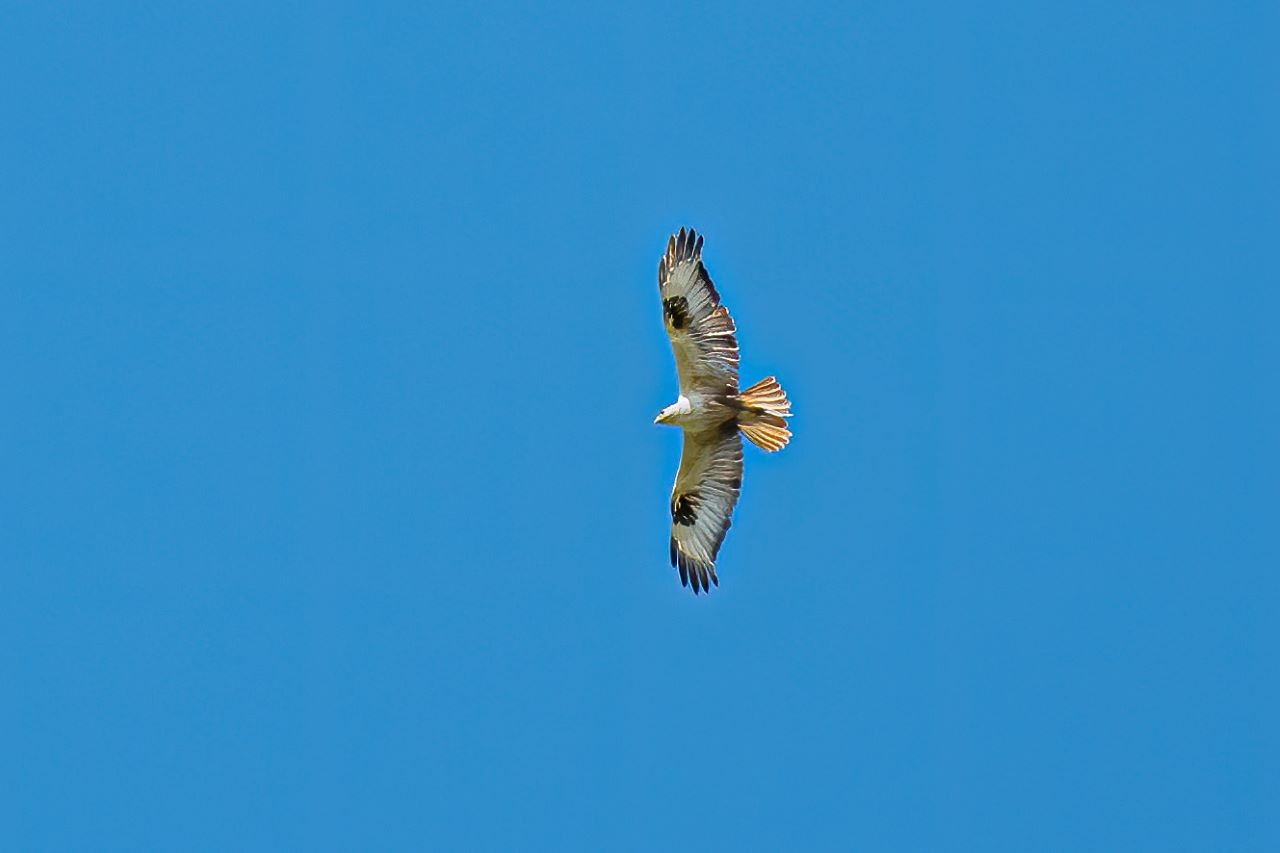
Ringing at Fyrhaven:
Common Whitethroat – Tornsanger – 1
People: Amandine Doré, Martina Hillbrand, Simon S. Christiansen og Frederik R. Johansen.
Klik her for at se dagens observationer indtastet i Dofbasen af observatører i området
Massere af måger og et Farvel og på gensyn
I dag blæste det rigtig meget, så vi kunne desværre ikke ringmærke i dag.
Amandine, Martina og jeg tog ud for at tælle terner, og jeg besluttede mig for at tælle de rastende måger på stranden, for der var edermageme mange!
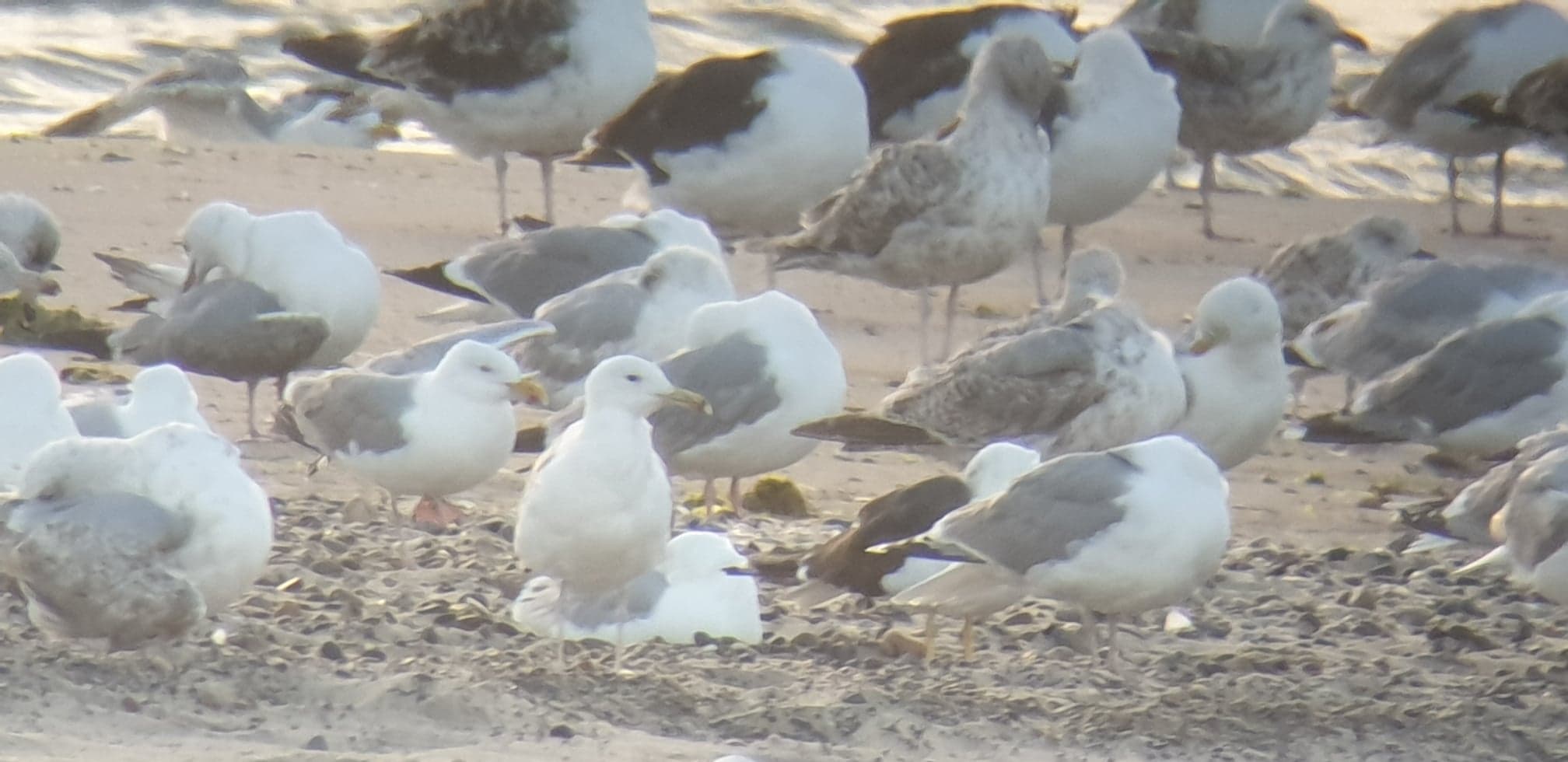 Vi talte mindst 4960 rastende måger, men der var hele tiden nogen der fløj, så der har helt sikker været over 5000 rastende måger!!!!!!!
Vi talte mindst 4960 rastende måger, men der var hele tiden nogen der fløj, så der har helt sikker været over 5000 rastende måger!!!!!!!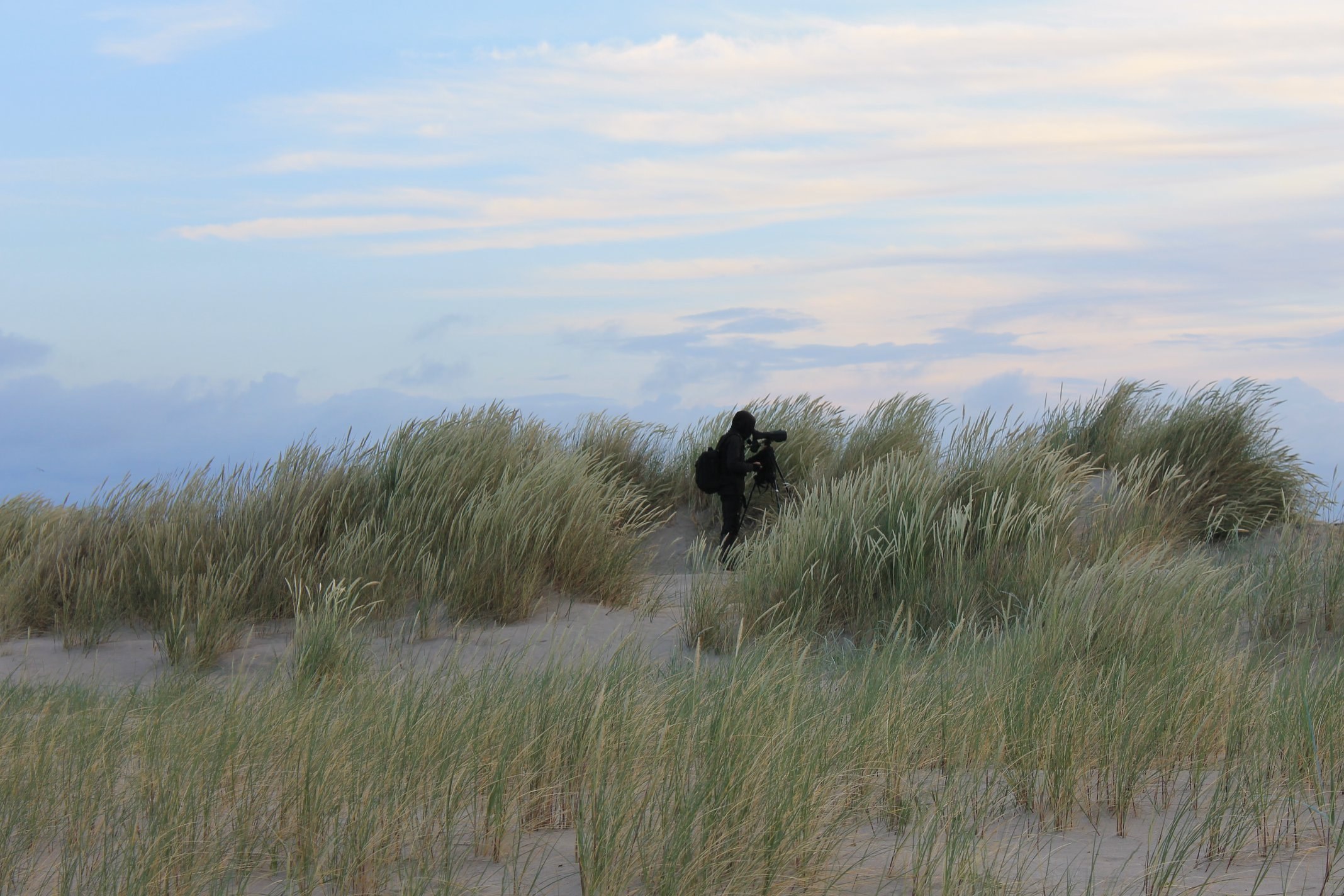
Mågeflokken bestod af:
Sølvmåge - 3722
Hættemåge - 146
Sorthovedet Måge - 1 (2k)
Ride - 3
Stormmåge - 427
Sildemåge - 427
Kaspisk Måge - 1 (måske en mere)
Svartbag - 233 (+en med en blå farvering)
Amandine og Martina talte:
Splitterne - 37
Fjordterne - 2
Rosenstæren var stadig på plads ude ved Grenen-spidsen, og den var lige så fantastisk smuk som den var i går!!!
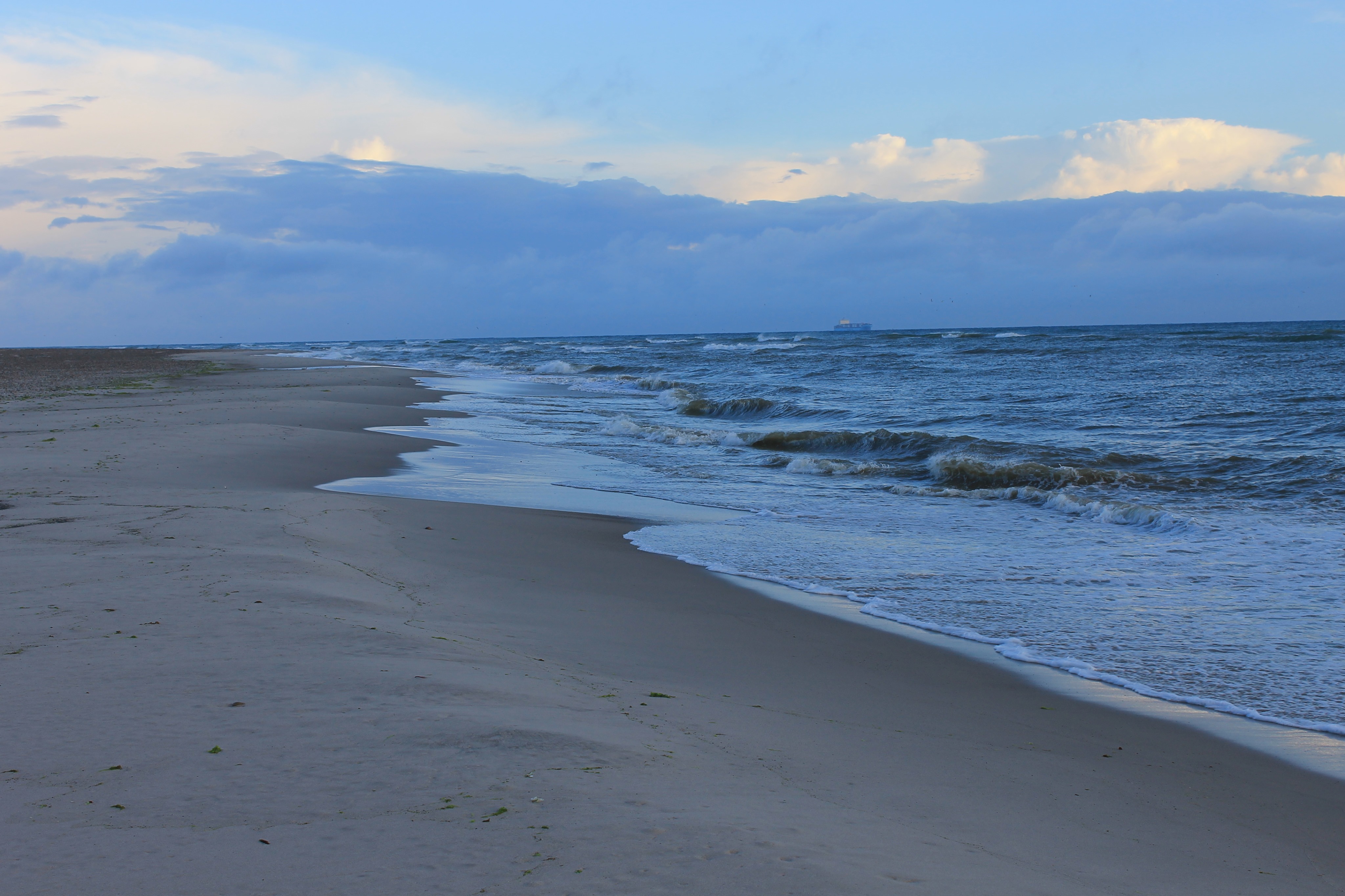 Jeg tog efterfølgende hjem, hvor Amandine kom 20 min efter.
Jeg tog efterfølgende hjem, hvor Amandine kom 20 min efter.
Martina tog ud til Kabeltrommelkrattet for at stramme nogen net, og sætte et nyt net op.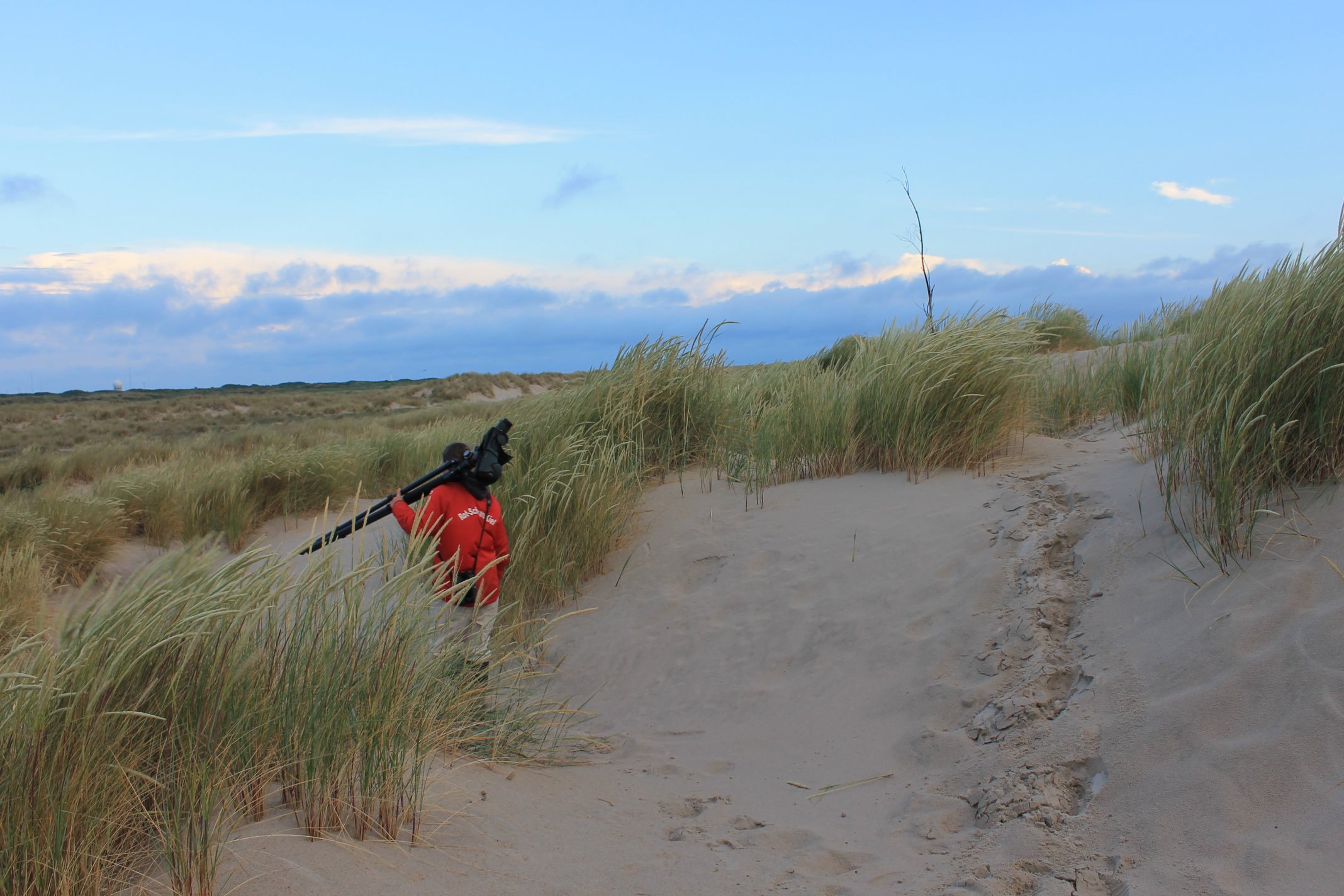
Klokken 14.00 ca. tog vi på ringmærkningstur. Det gik fint, selvom vi ikke fangede nogen fugle.
I dag er min sidste dag heroppe på Skagen Fuglestation, og det betyder jo så også at dette er min sidste blog, lige foreløbig. Det har været et fantastisk forår, og på gensyn ;)
Klik her for at se dagens observationer indtastet i Dofbasen af observatører i området
Folk: Amandine Doré, Martina Hillbrand, Simon S. Christiansen og Frederik R. Johansen.
A Rosy Starling (Rosenstær) in Grenen and a lot of raptors!
Today, Martina and Frederik went opening the net, while I enjoyed an hour more of extra sleep and then joined them for the first net check at 4:15am.
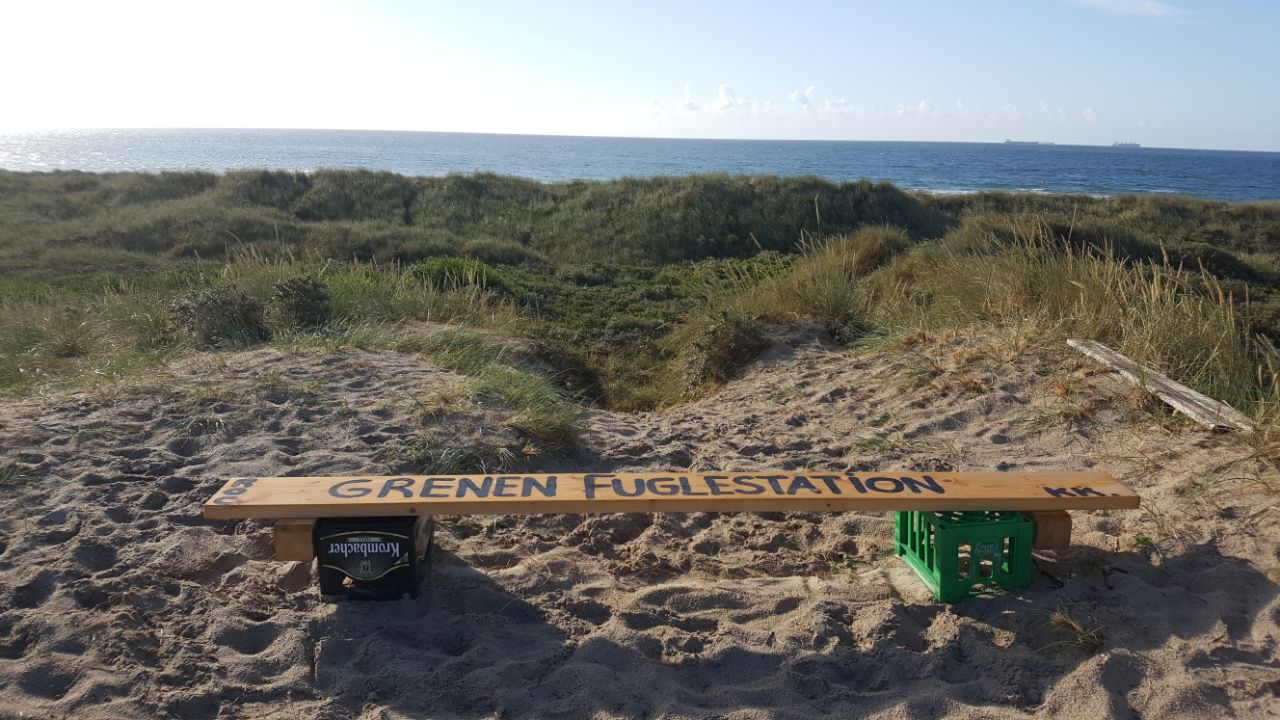
The morning was very slow, only a few birds were caught in the nets. However, someone spotted a Rosy Starling (Rosenstær) next to the tip of Grenen beach, which is also close to Kabeltromlen where we are ringing. We took turn and went down to the beach between net checks to see this Rosy Starling. It was flying among a flock of Common Starlings (Stær), and fortunately, we all managed to get a good view of it ! Simon joined the ringing later on and also went to check this Rosy starling.
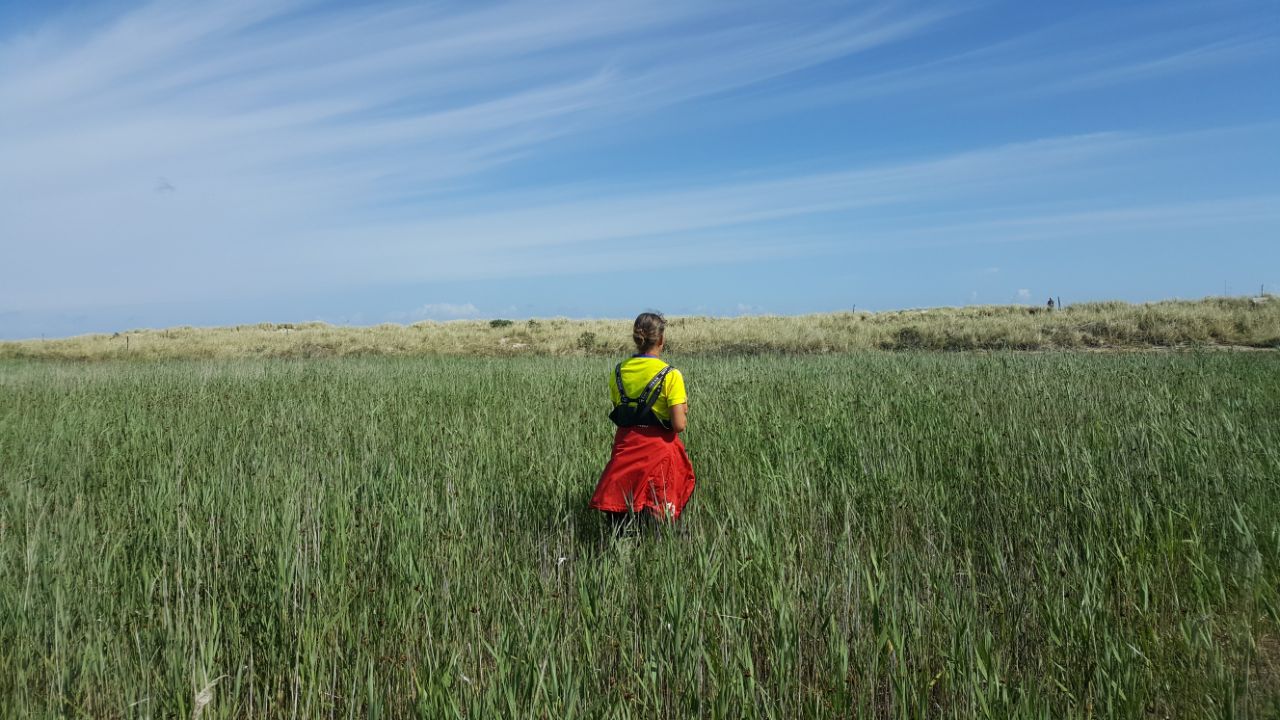
Looking for the Rosy Starling
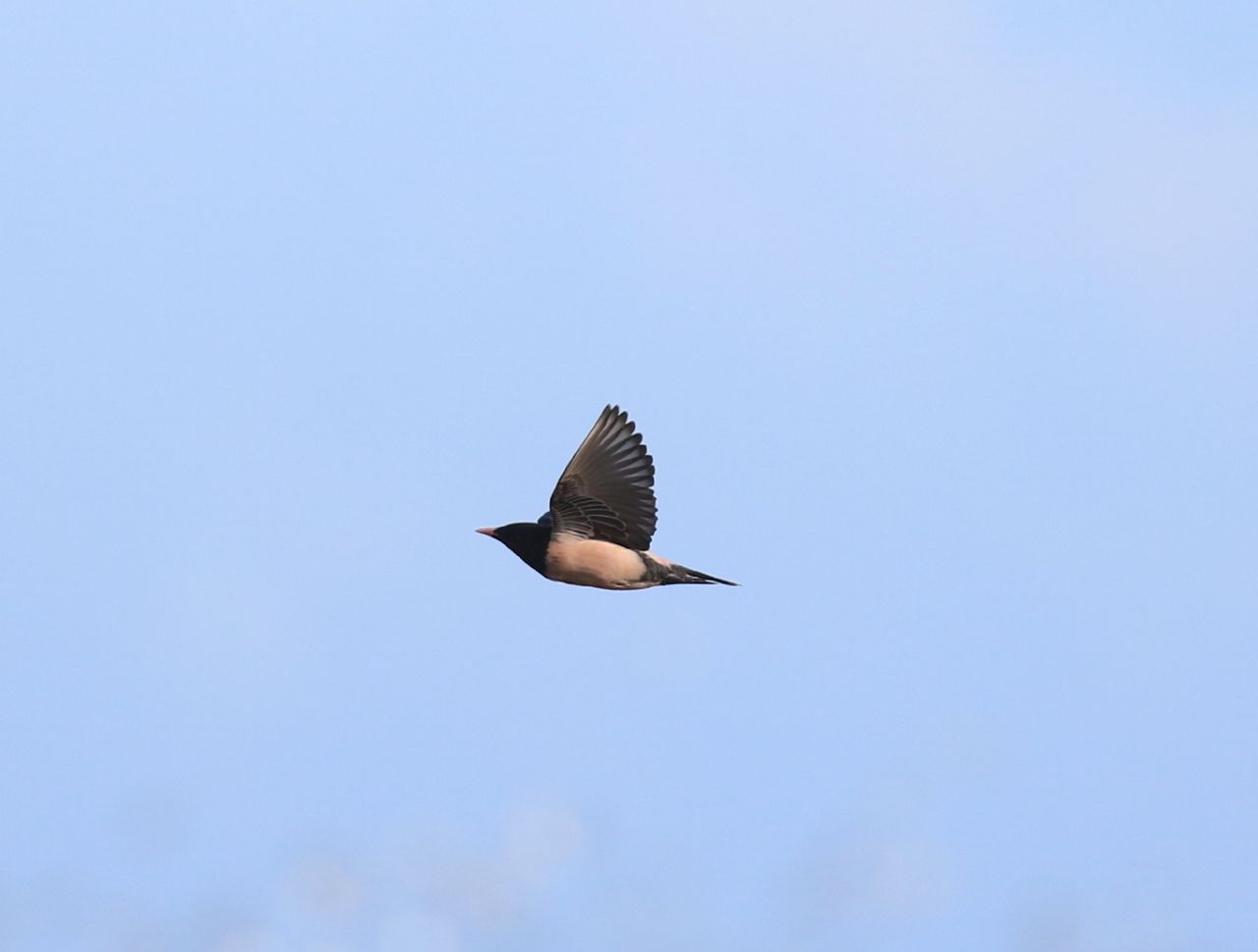
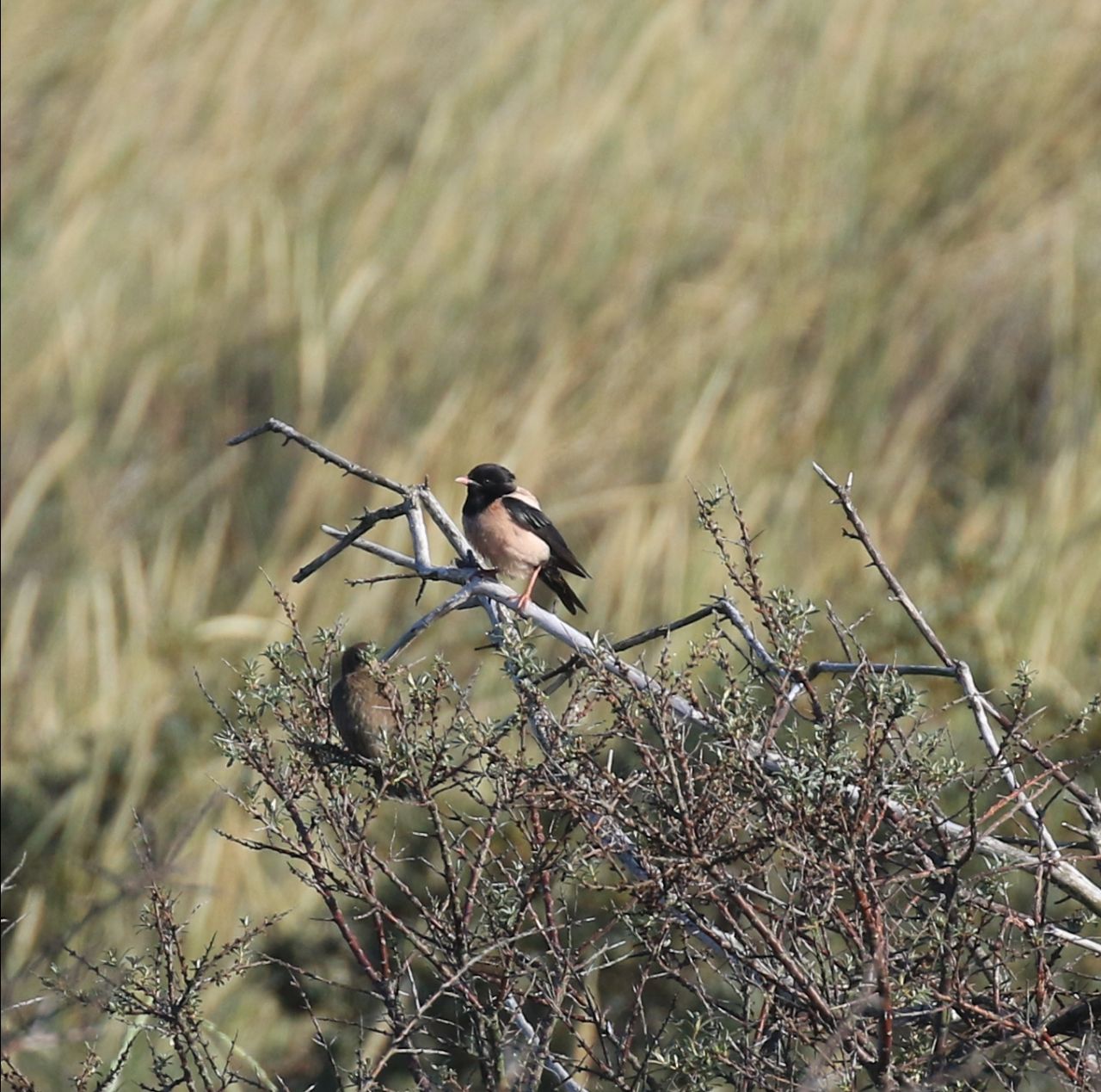 Here it is !
Here it is !
The morning became even more exciting as Simon spotted some Black Kites (Sort glente), a White-tailed Eagle (Havørn) and a Golden Eagle (Kongeørn). A lot of raptors were flying around: Red Kites (Rød glente), Common Buzzards (Musvåge), Honey Buzzards (Hvepsevåge), Kestrel (Tårnfalk )….
In the early morning, Frederik also observed a Golden Oriole (Pirol) chasing a Sparrowhawk (Spurvehøg) !
After two net checks without any birds, we decided to close early. On our last net check before closing, we caught a very nice second calendar year male Grey Wagtail (Bjergvipstjert).
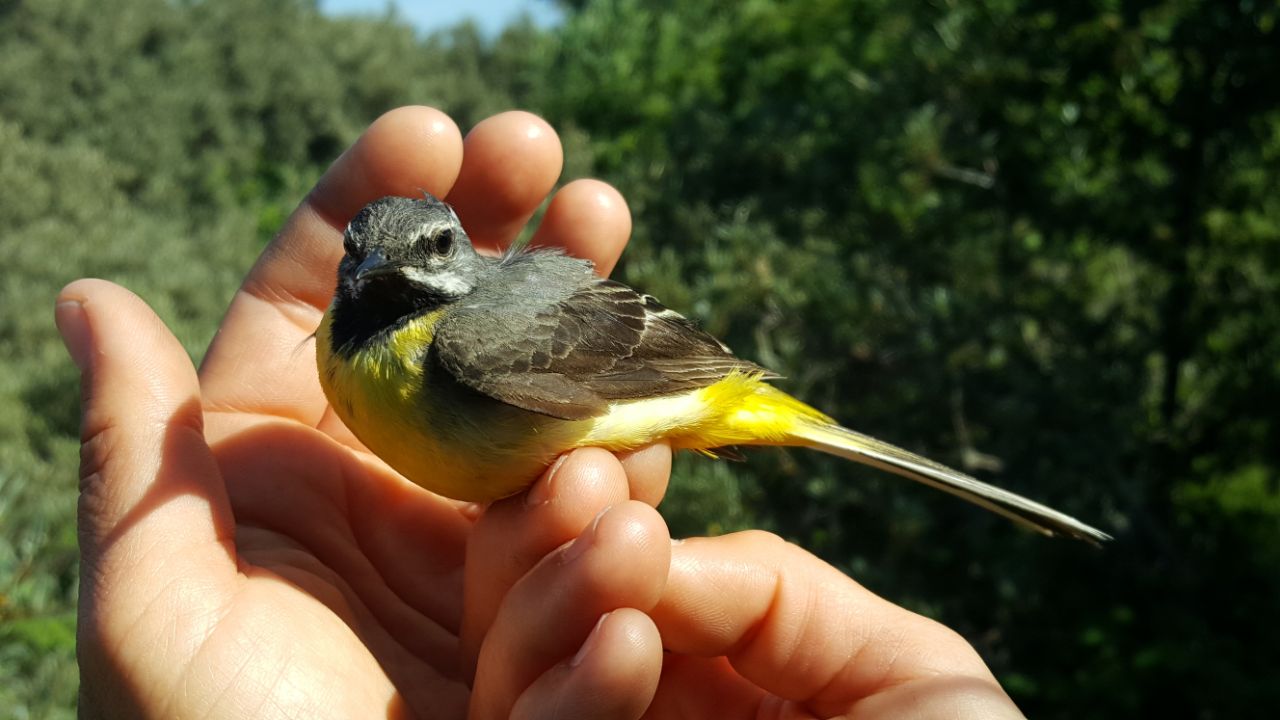
Grey Wagtail (Bjergvipstjert)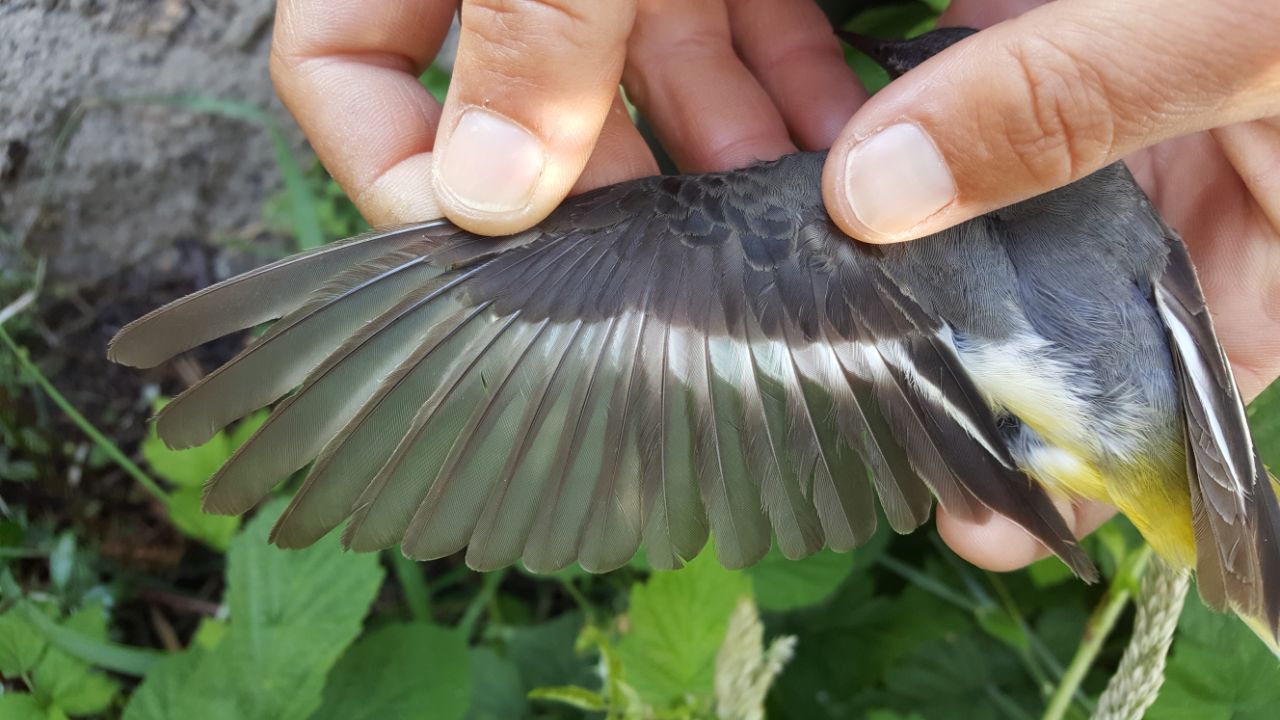
This morning that had started very slow ended up being very exciting !
Ringmærkning (Kabeltromlen)
Munk – Blackcap – 3
Gærdesanger – Lesser Whitethroat – 2
Tornsanger – Common Whitethroat – 1
Kærsanger – Marsh Warbler – 6
Rørsanger – Reed Warbler – 1
Bjergvipstjert – Grey Wagtail – 1
Bogfinke – Chaffinch - 1
Grå Fluesnapper – Spotted Flycatcher – 1
Gærdesmutte – Wren – 1
Løvsanger – Willow Warbler – 1
Total: 18
People : Martina Hillbrand, Simon S. Christiansen, Frederik R. Johansen and Amandine Doré
Klik her for at se dagens observationer indtastet i Dofbasen af observatører i området
Klik her for at se opsummeret observationer af rovfugle i Skagen
Ringing, Pride Run and dinner with the Friends of the Observatory !
Today Martina and I went ringing at Kabeltromlen. Frederik did not join the ringing as he had been out the whole listening to night birds with Simon.
We had to open the nets one hour later because of the rain. Despite a cloudy weather, we caught quite few birds in the nets, and opened until 10, when it started raining again. After the Blackcap (Munk) wave of last week, today was the Lesser Whitethroat (Gærdesanger) invasion ! We catch new Lesser Whitethroats every day, which is surprising as we would expect them to be all ringed by now since they are resident birds. Some of them have starting moulting their feathers.
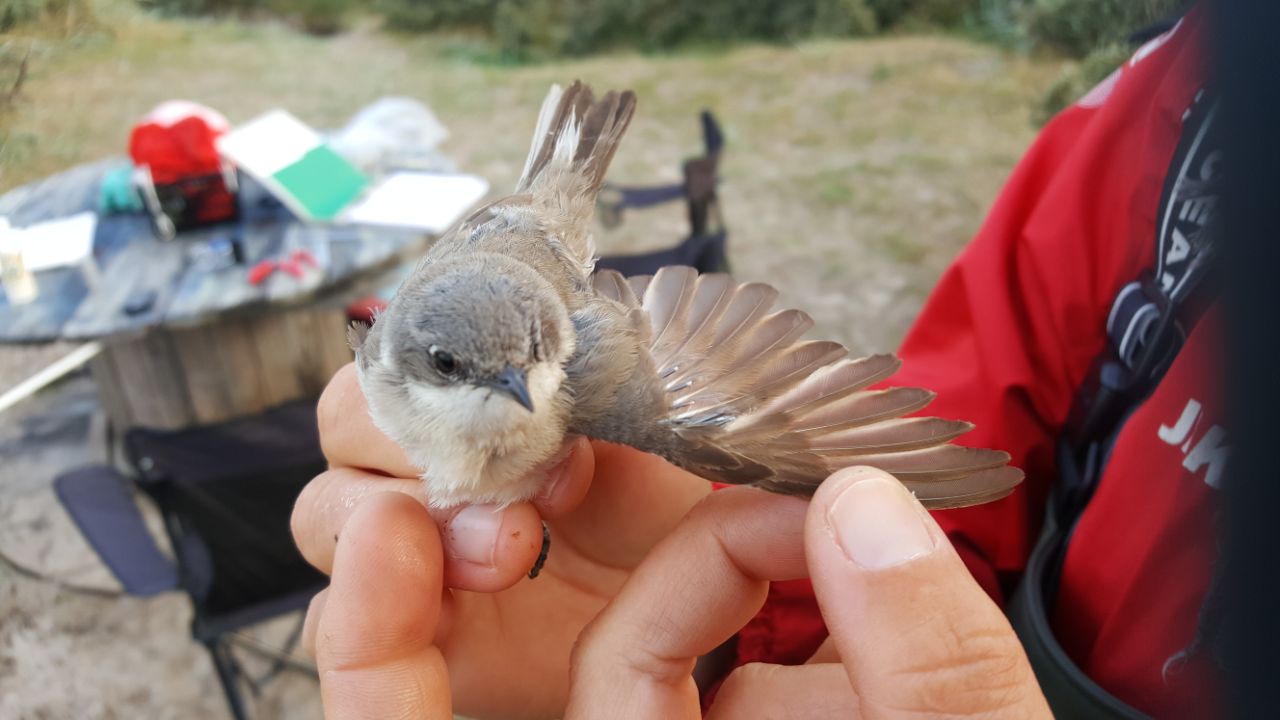 Lesser Withetroat (Gærdesanger) moulting its feathers
Lesser Withetroat (Gærdesanger) moulting its feathers
We caught a nice juvenile Reed Bunting (Rørspurv), showing the species’ typical dark brown streaked pattern on the wings. Later on, we caught a beautiful adult male.
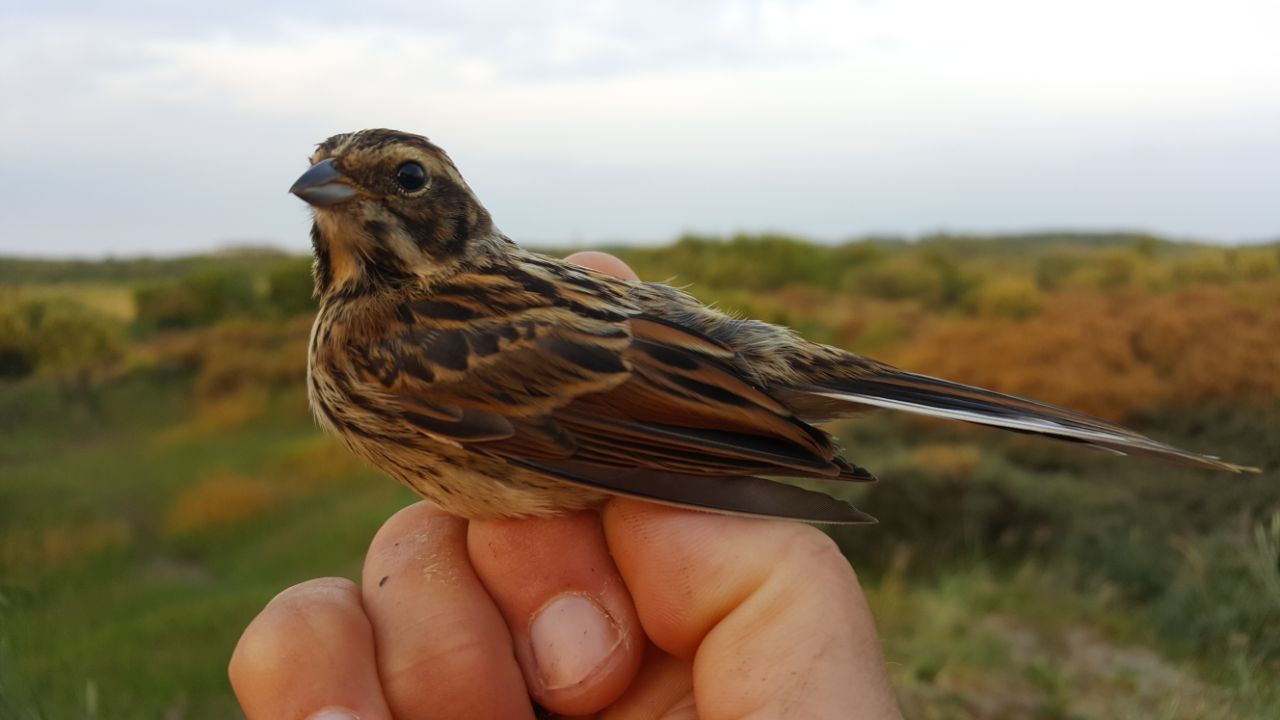 Juvenile Reed Bunting (Rørspurv)
Juvenile Reed Bunting (Rørspurv)
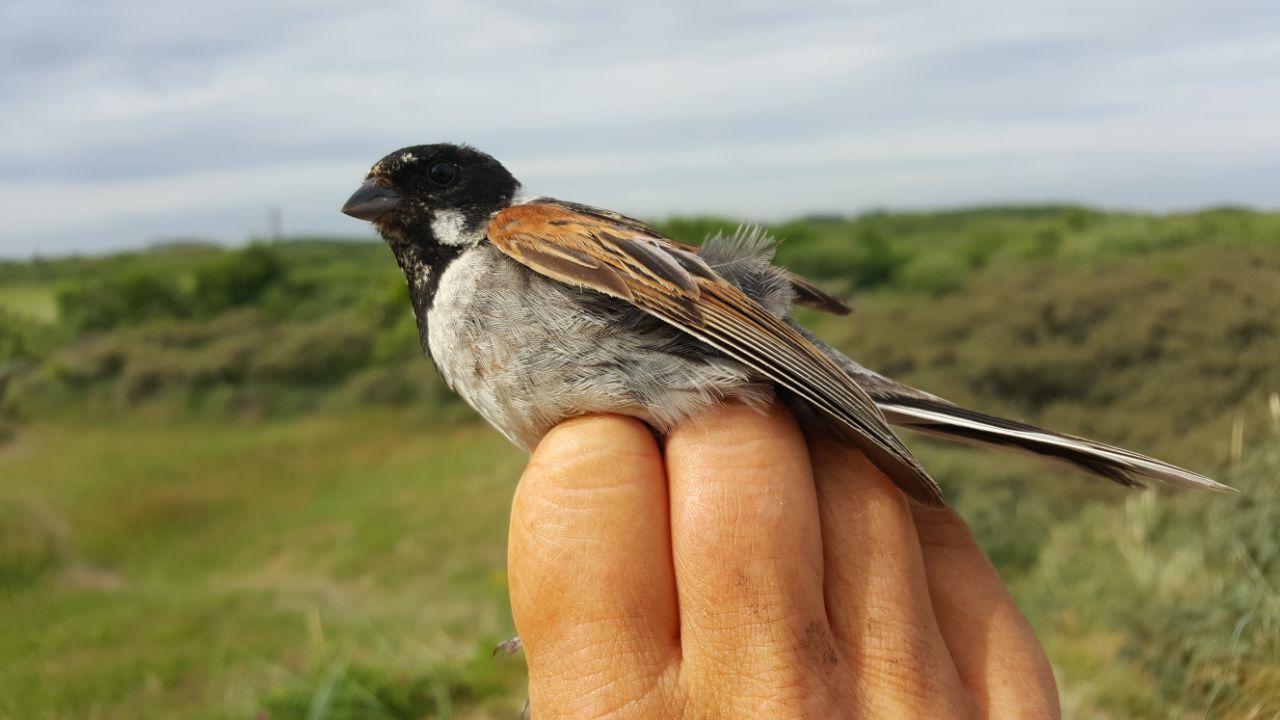
Adult male Reed Bunting (Rørspurv)
We also caught several Lesser whitethroats (Gærdesanger) hatched this year, and our first Common Whitethroat (Tornsanger) hatchling ! We are still waiting for the Blackcaps (Munk) hatchlings to be caught in the nets ! It should happen very soon!
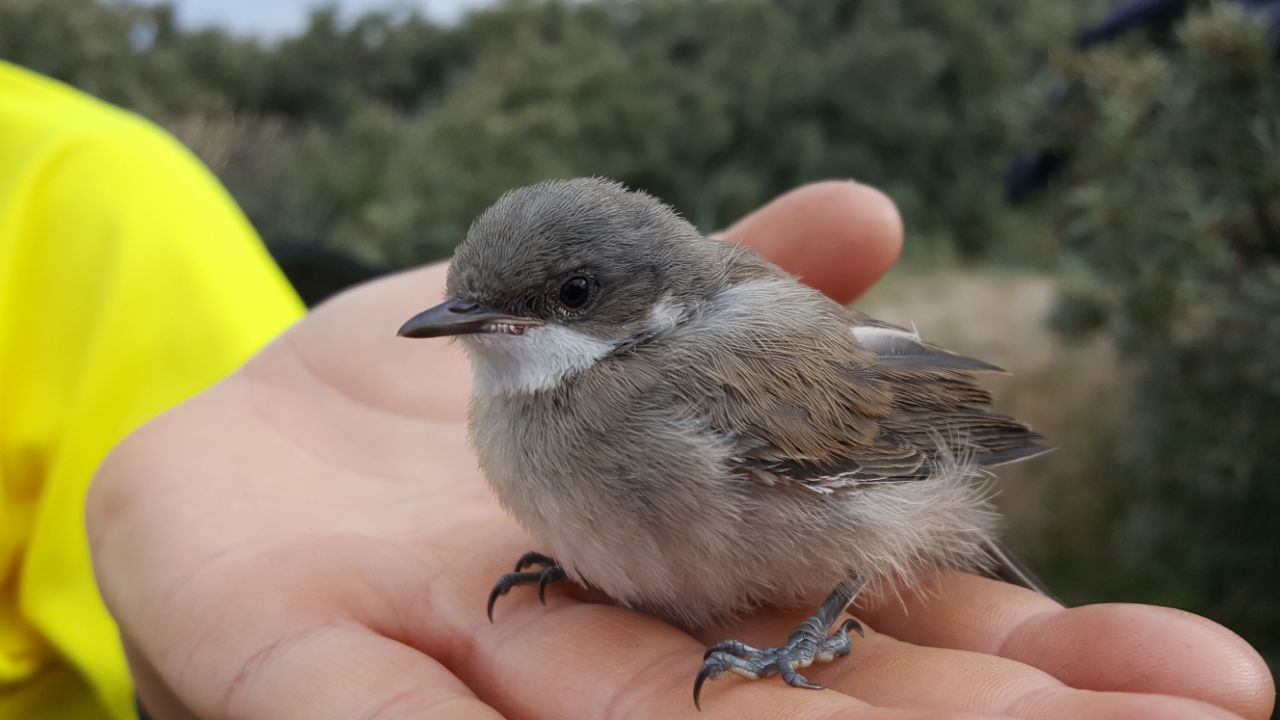 Juvenile Lesser Whitethroat (Gærdesanger)
Juvenile Lesser Whitethroat (Gærdesanger)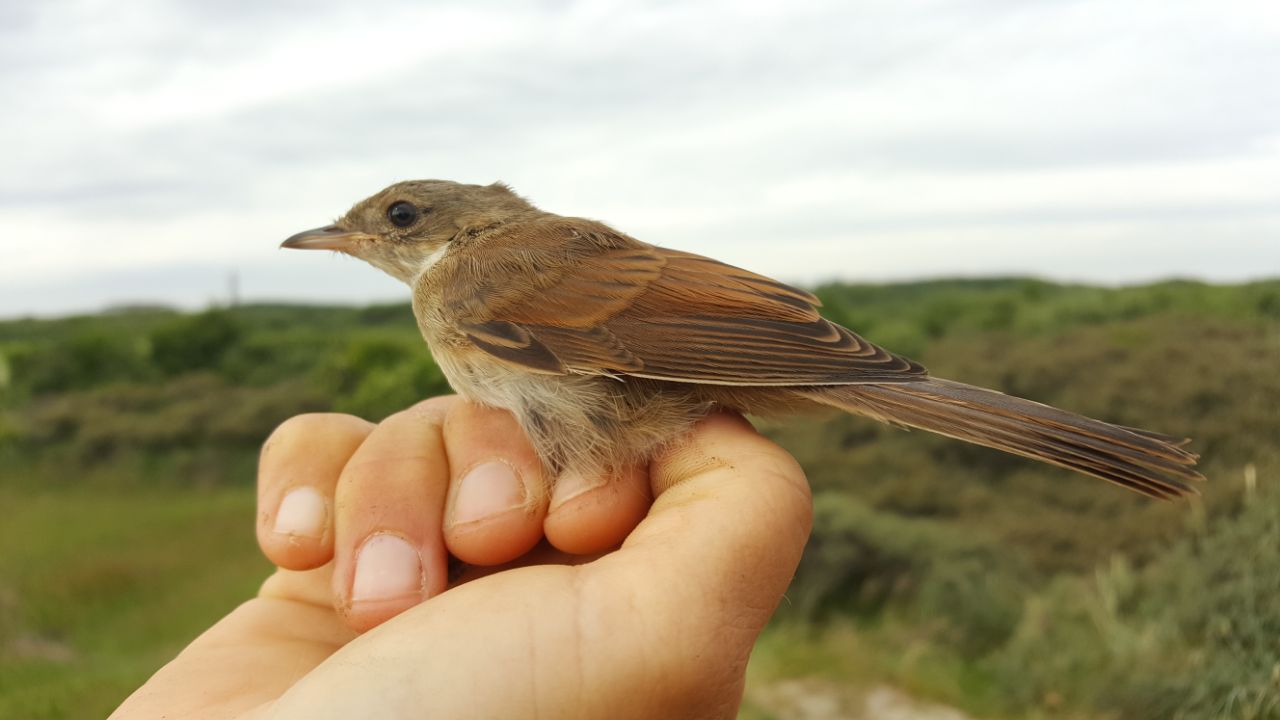
Juvenile Common Whitethroat (Tornsanger)
After the ringing we went back home and got some sleep to get ready for the Virtual Pride Run Pernille, Martina and myself had enrolled for. We ended up running 6 km, it was nice and fun.
Tonight, an outdoor dinner was organized at the Grey Lighthouse by the Friends of the Observatory. The weather was unfortunately not very good, and several showers interrupted the event, however everything turned out well.
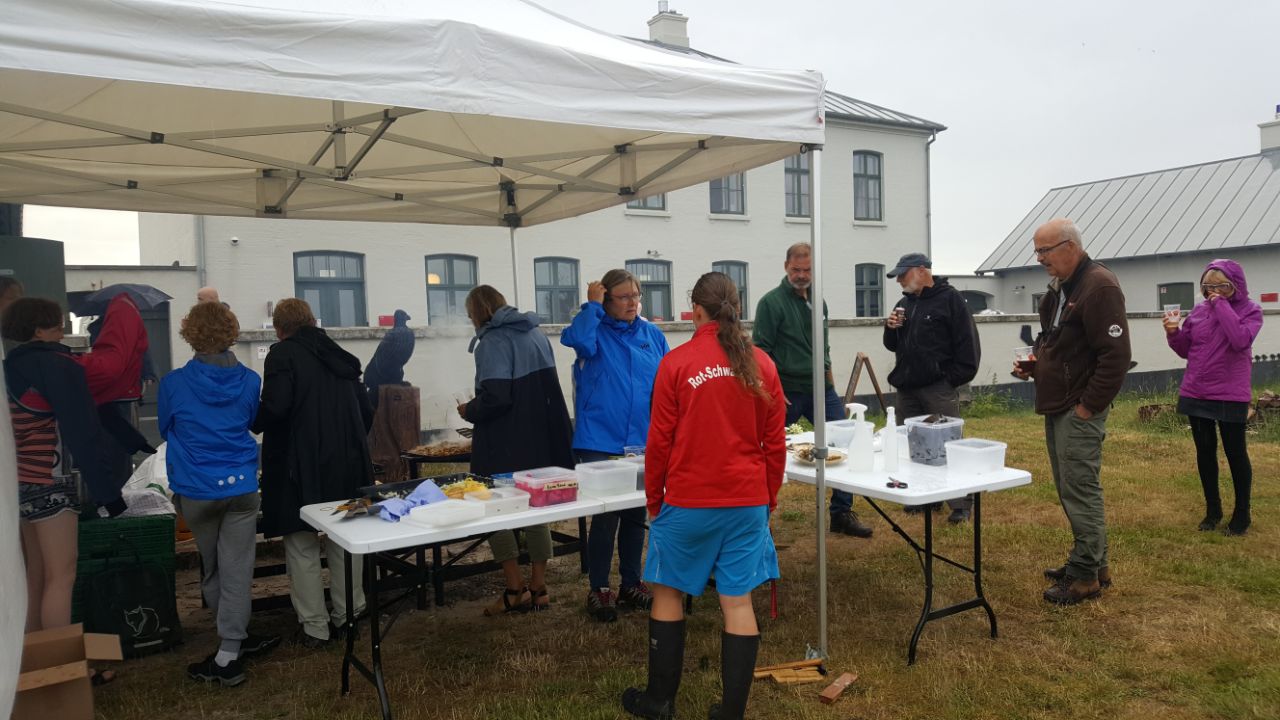
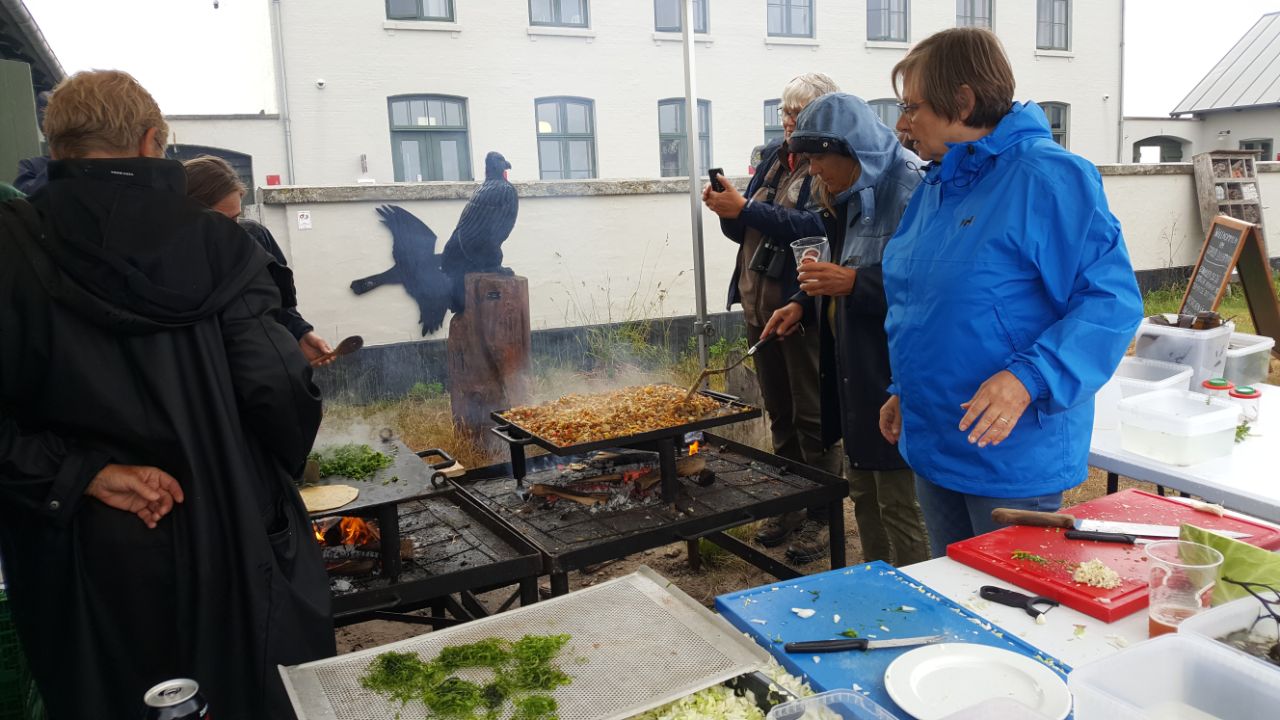
The dinner was very good and had interesting flavours, using local ingredients such as different algae collected in the sea during the afternoon, as well as rosehips growing around the lighthouse.
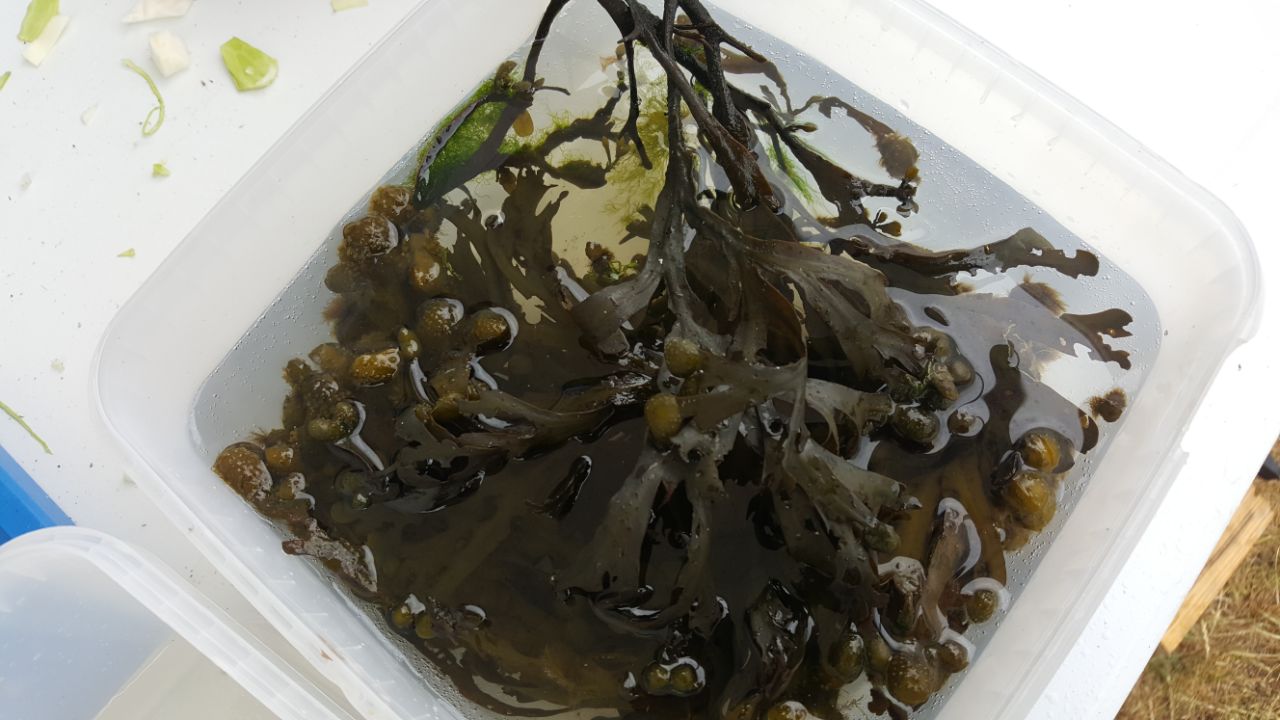
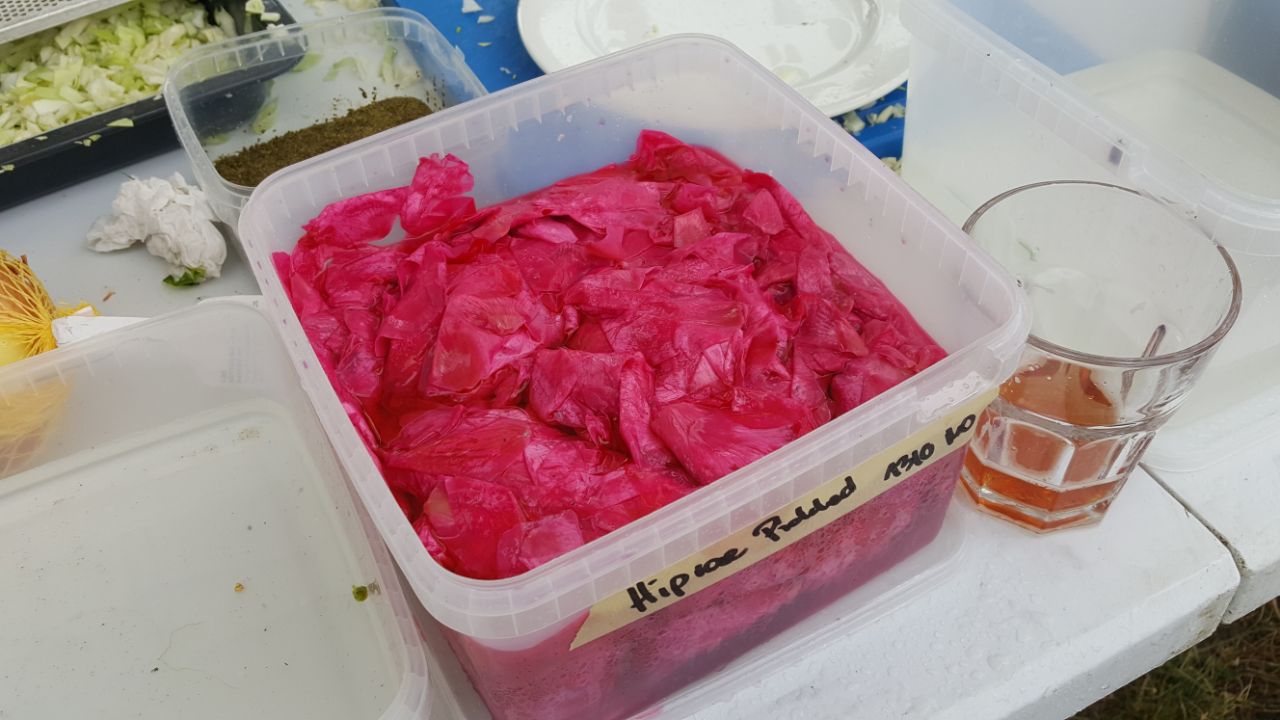
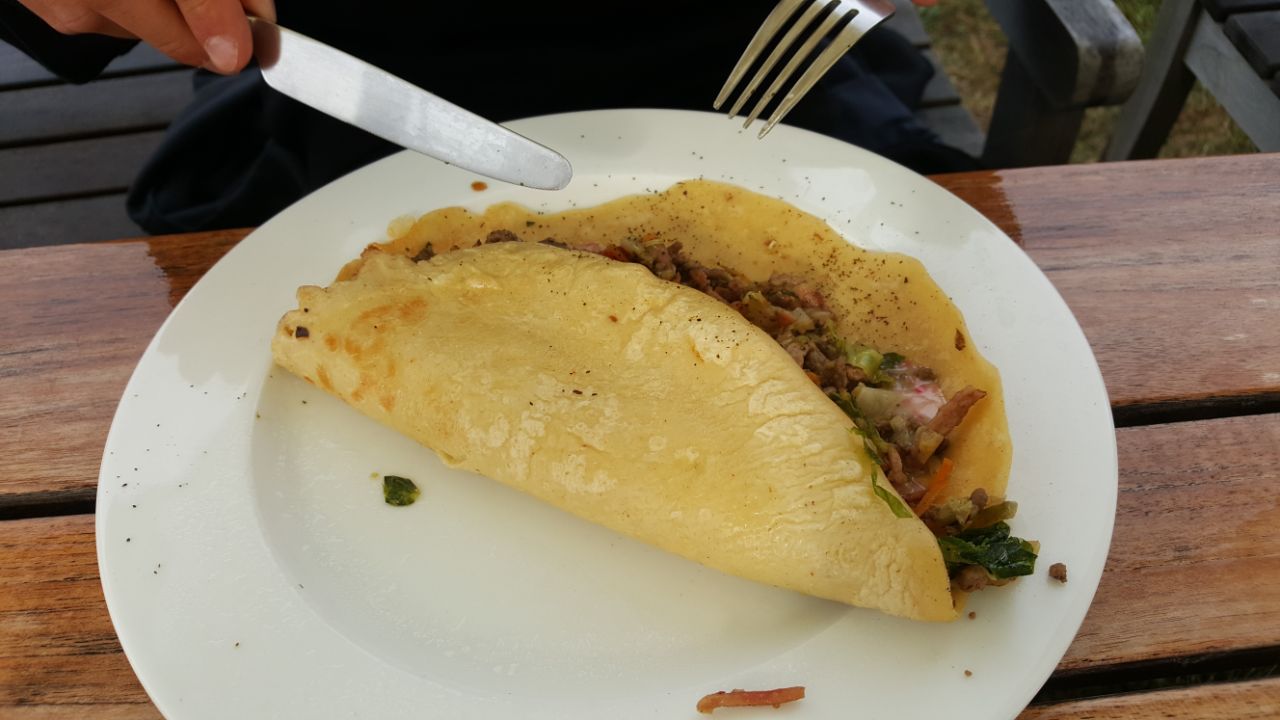
Ringmærkning (Kabeltromlen):
Gransanger – Chiffchaff - 1
Lille Dompap – Bullfinch – 1
Bogfinke – Chaffinch - 5
Havesanger – Garden Warbler - 1
Tornsanger – Common Whitethroat – 4
Munk – Blackcap – 13
Topmejse – Crested Tit – 3
Kærsanger – Marsh Warbler – 4
Rørsanger – Reed Warbler – 2
Sangdrossel – Song Thrush – 1
Gærdesmutte – Wren – 2
Gærdesanger – Lesser Whitethroat – 2
Solsort – Blackbird – 2
Rødhals – Robin - 1
Skovpiber – Tree Pipit – 1
Blåmejse – Blue Tit – 1
Skægmejse – Bearded Tit – 2
Bjergvipstjert – Grey Wagtail – 1
Kernebider – Hawfinch – 1
Lille Gråsisken – Redpoll – 3
Broget Fluesnapper – Pied Flycatcher – 1
Løvsanger – Willow Warbler – 1
Vindrossel - Redwing - 2
Rørspurv – Reed Bunting -
Total: 39
People : Martina Hillbrand, Frederik R. Johansen, Simon S. Christiansen, Amandine Doré and Pernille Roed.
Klik her for at se dagens observationer indtastet i Dofbasen af observatører i området
Klik her for at se opsummeret observationer af rovfugle i Skagen
En Sommerdag
Dagen i dag startede ud med at Martina tog ud til Jennes Sø, for at åbne nettene til CES-mærkning. Det gik meget stille under ringmærkningen med meget få fugle.
Imens Martina og jeg mærkede ved Jennes Sø, tog Amandine ud til Skarvsøen, for at tælle og tjekke op på Skarvkolonien. Det så godt ud, og ungerne ser sunde ud.


Klokken 10.30 cyklede vi hjem til fuglestationen. Martina og Amandine gik i seng, og jeg tog ud for at kigge efter en Ørnevåge, som havde været her i går. Det lykkedes ikke....
Isblåfugl
Hertil eftermiddag, tog Martina til Nordstrand for at kigge efter Store Præstekraver (især unger), men det lykkedes desværre ikke for hende. Hun så nogen fiskene Splitterner, som nok samler føde til deres unger.
Senere i aften tager Simon og jeg på natlyt. Vi håber på noget godt (Buskrørsanger mindst ;) ).
Folk: Amandine Doré, Martina Hillbrand og Frederik R. Johansen.
Klik her for at se dagens observationer indtastet i Dofbasen af observatører i området
Klik her for at se opsummeret observationer af rovfugle i Skagen
Water rails have fledged
This morning we went ringing as usual. The night was not quite as long as the night before, so we actually did sleep before getting up at 2.30 again. However, it was a late night nonetheless, quite unexpectedly since we were all really tired from the long nightjar night. But at dinner Simon informed us that somebody had reported an injured Gannet (Sule) on North Beach. It was ringed and he wanted us to catch it to be able to read the ring and if necessary take the bird to a rehabilitation center.
Amandine and I went with our guests Jesper and Anne went to the beach to catch the poor bird. After a short search we found the bird. We came up with a strategy to catch it but we did not know how mobile the bird was. So at the first try we failed quite badly, since the bird managed to escape into the water between Amandine and me. It swam only for a short time and then came back to the beach, also showing that it must be in rally bad shape. The second time we were better prepared, came from deeper in the water and managed to catch it quickly. Once we had the bird we saw the damage: it had a broken lower mandible. Clearly it couldn’t feed any more. This might have happened when the bird tried to catch a fish that was caught in a fisherman’s net. The bird was full of insects and it was clear that it was not going to survive left on its own so we called wildlife rescue. Unfortunately they could only tell that an adult bird like this with a broken bill could not be fed (and we did experience how vicious it was when we needed two people to hold it), so he advised us to kill the bird to not let it suffer any longer. Jesper was so kind and do that for us as none of the women wanted to take care of that. We did admire its long, beautiful wings, though. It is such an elegant bird which makes it even harder to see it die this way.
On the plus side: we were able to report the ring to London and hope to hear soon how old this bird was and where it was born. We will keep you updated.
On the brighter side of life we had a nice sunrise again in the morning and opened the nets to a very warm day. Compared to yesterday the ringing was quite slow but nonetheless brought us some very interesting species. The biggest surprise of the day was a nuthatch (spætmejse). Some were seen to pass through on migration – probably first-year birds on juvenile dispersal and one of them ended up in our nets. We do not normally catch this species, so we were very excited about it.
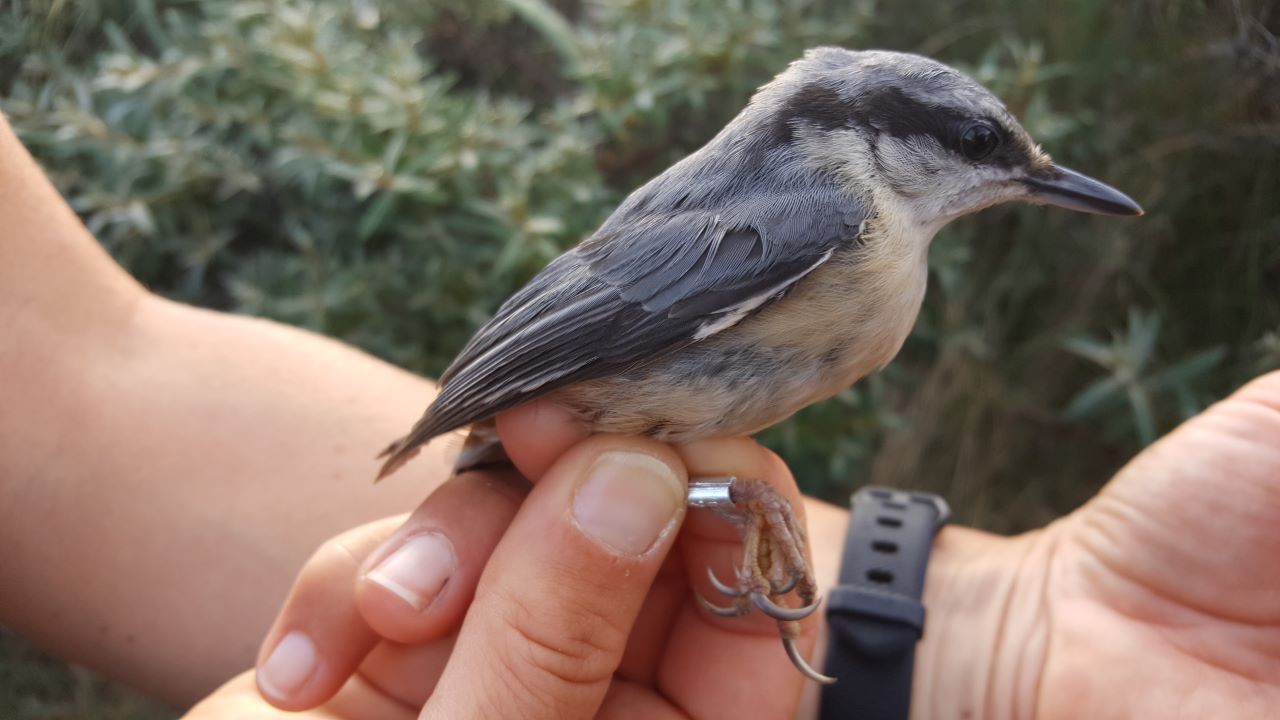
Another really nice bird was the water rail (vandrikse). We know that the species was nesting close to our nets because we heard them every morning. We also set out traps for many days specifically to catch the rails, however, it never succeeded. All the water rails we caught were caught in the nets. Today we caught a juvenile which, obviously, was already able to fly very well. The weird sounds that they make are misleading: they are actually very pretty birds.
For the rest we did not catch anything special, just the local and regional breeding birds. We are getting more and more juvenile birds in the nests now, so it is really nice for us to see every day a new species has fledged. Today we caught a juvenile chiffchaff (gransanger) and a blue tit (blåmejse) – next to the already known lesser whitehtroats (gærdesanger) and crested tits (topmejse).
In the afternoon we set up the nets at Jennes Sø so that we can do the CES ringing there tomorrow.
Ringmærkning (Kabeltromlen):
Gransanger – Chiffchaff - 2
Munk – Blackcap – 5
Gærdesanger – Lesser Whitethroat – 7
Bogfinke – Chaffinch - 1
Vandrikse – Water Rail – 1
Blåmejse – Blue Tit – 1
Spætmejse – European Nuthatch – 1
Rørsanger – Reed Warbler – 1
Tornsanger – Common Whitethroat – 2
Sangdrossel – Song Thrush – 1
Topmejse – Crested Tit – 4
Total: 25
People : Martina Hillbrand, Simon S. Christiansen, Frederik R. Johansen, Amandine Doré, Jesper and Anne Sandfeld
Klik her for at se dagens observationer indtastet i Dofbasen af observatører i området
Klik her for at se opsummeret observationer af rovfugle i Skagen
Natravn, Vinsværmer og Korttået Lærke!
Vores dag i dag startede faktisk allerede i går aftes. Vi skulle nemlig ud for at fange Natravne med Lars Bo! Vi drog afsted mod Sandmilen klokken 21.30 i går aftes, for at sætte nettene op. Vi havde været ude en gang før (for 2 uger siden), hvor vi intet fangede, så forventningerne var lidt forskellige :)
Men klokken 00.15 røg der en Natravn i nettet!!!!! Holy moly den var bare fed!
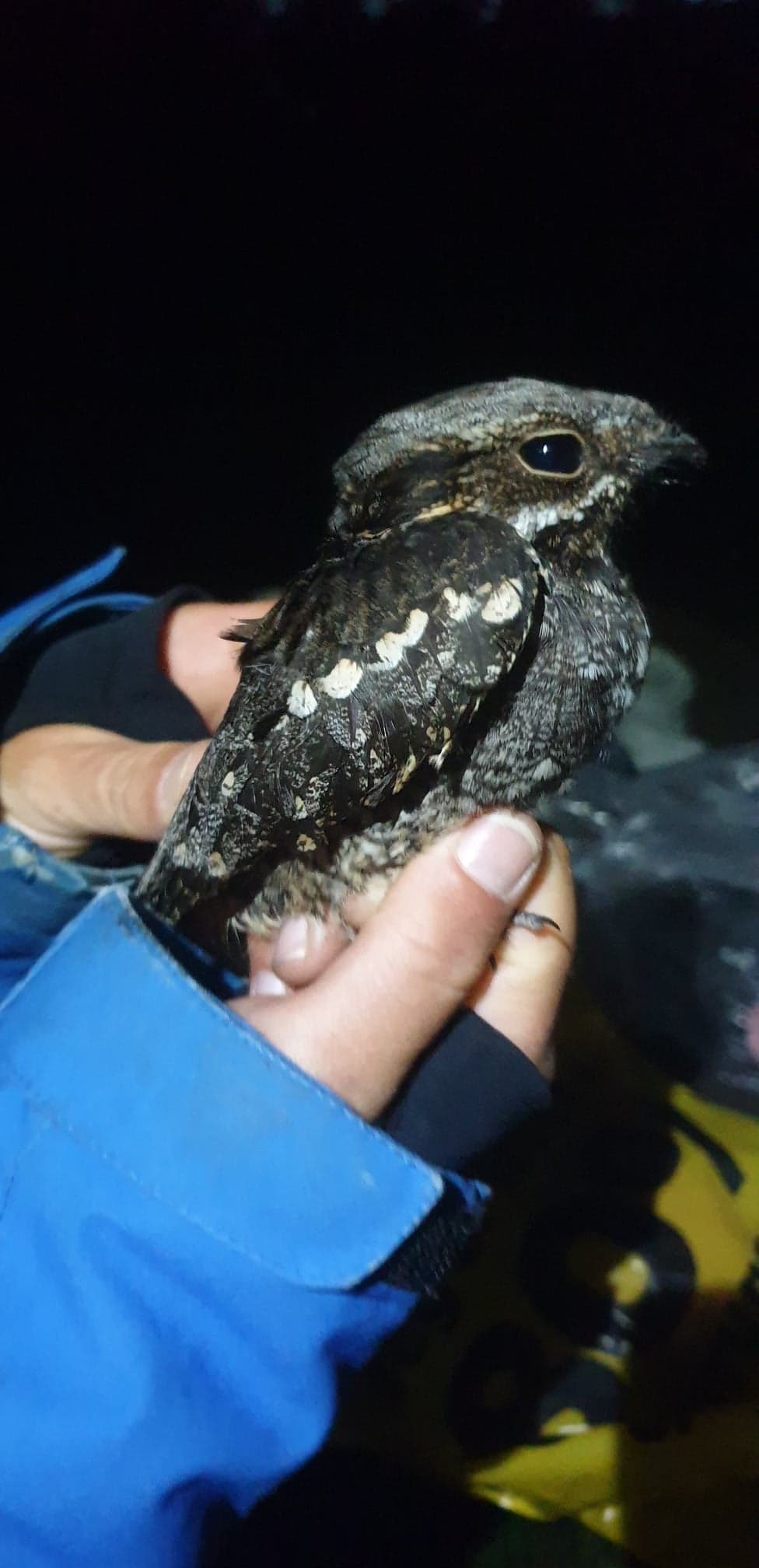
Klokken 02.00 havde Martina kørt med Laila hjem, så Martina kunne sætte nettene op ved Kabeltrommelkrattet.
Vi var faktisk så heldige, at vi fangede hele 5 Natravne i alt!!
Klokken 04.20 havde vi pakket det hele sammen og tog tilbage mod stationen.
Vi takker Lars Bo rigtig mange gange for hjælpen.
Vores lyslokker havde givet en stor gevinst, nemlig en Lille Vinsværmer!! Det er bare en fed sværmer!
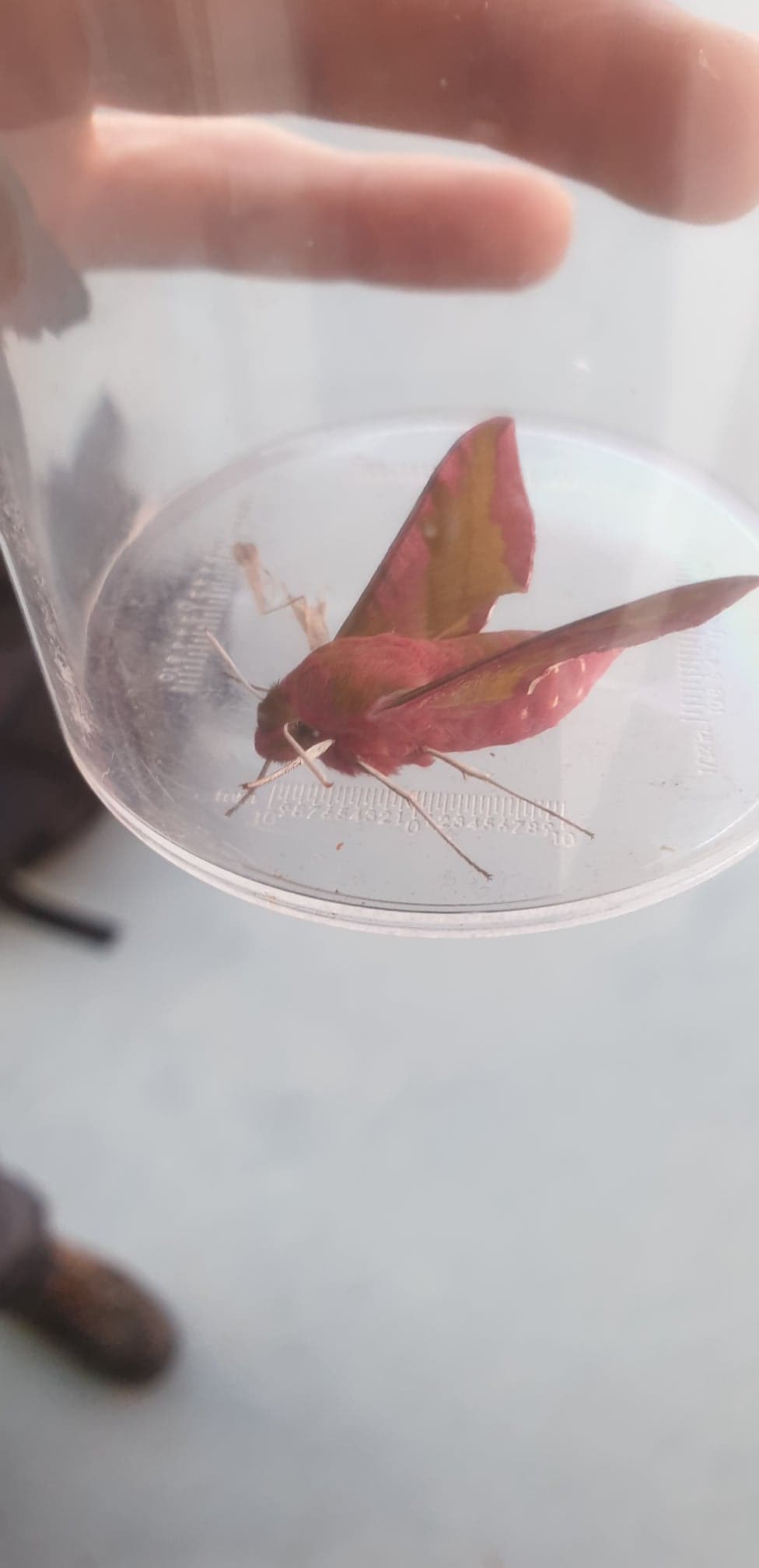
Derefter tog Amandine ud til Martina for at hjælpe i mærkningen, og jeg gik i seng.
Da jeg stod op ved 10-tiden, skete der noget fantastisk. Rolf Christensen melder en Korttået Lærke ud fra Grenen. En Korttået Lærke er en sjælden lærke-art, som kommer fra sydeuropa og længere østpå.
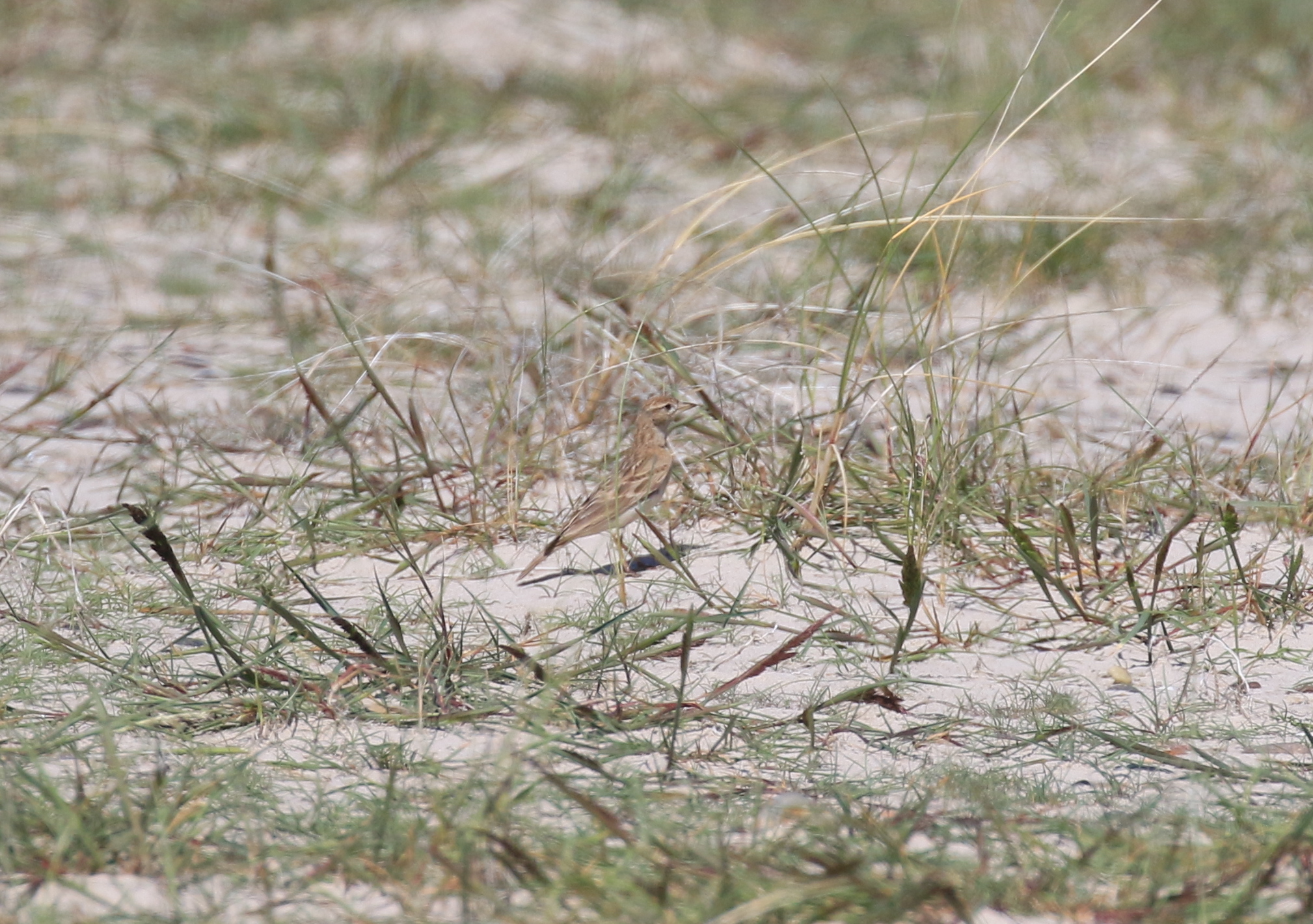
Den var altså bare virkelig fed!
Amandine og Martina fik sovet nogen par timer efter den lange nat.
Her til eftermiddag har vi lavet lidt praktisk arbejde.
Klik her for at se dagens observationer indtastet i Dofbasen af observatører i området
Klik her for at se opsummeret observationer af rovfugle i Skagen
Folk: Amandine Doré, Martina Hillbrand, Simon S. Christiansen, Lars Bo Jacobsen og Laila Neerman.
More and more juveniles birds !
This morning, Martina and me went out ringing at Kabeltromlen. The weather was very nice, warm and sunny, as it should be in summer ! We were unsure about how good the day will be for catching birds but we ended up having some nice species in the nets. We caught a female Bullfinch (Dompap Lille) as well as one juvenile and one adult male Reed Bunting (Rørspurv).
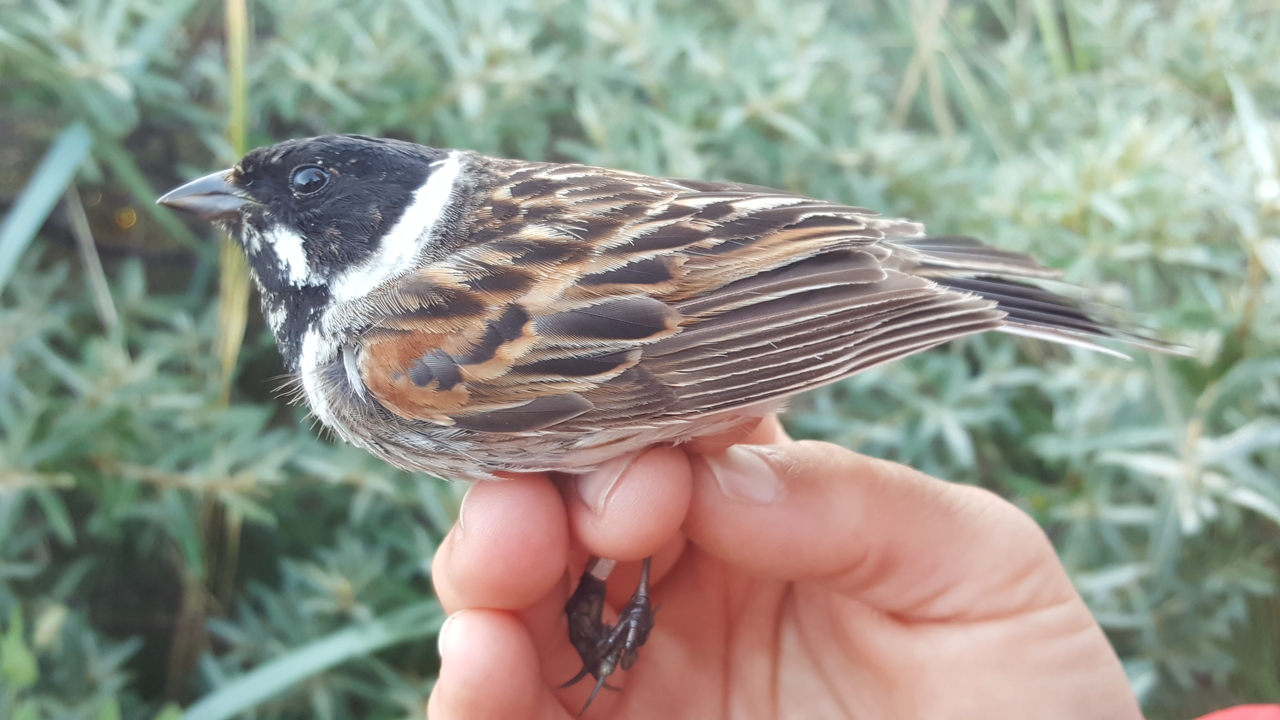 A nice male Reed Bunting (Rørspurv)
A nice male Reed Bunting (Rørspurv)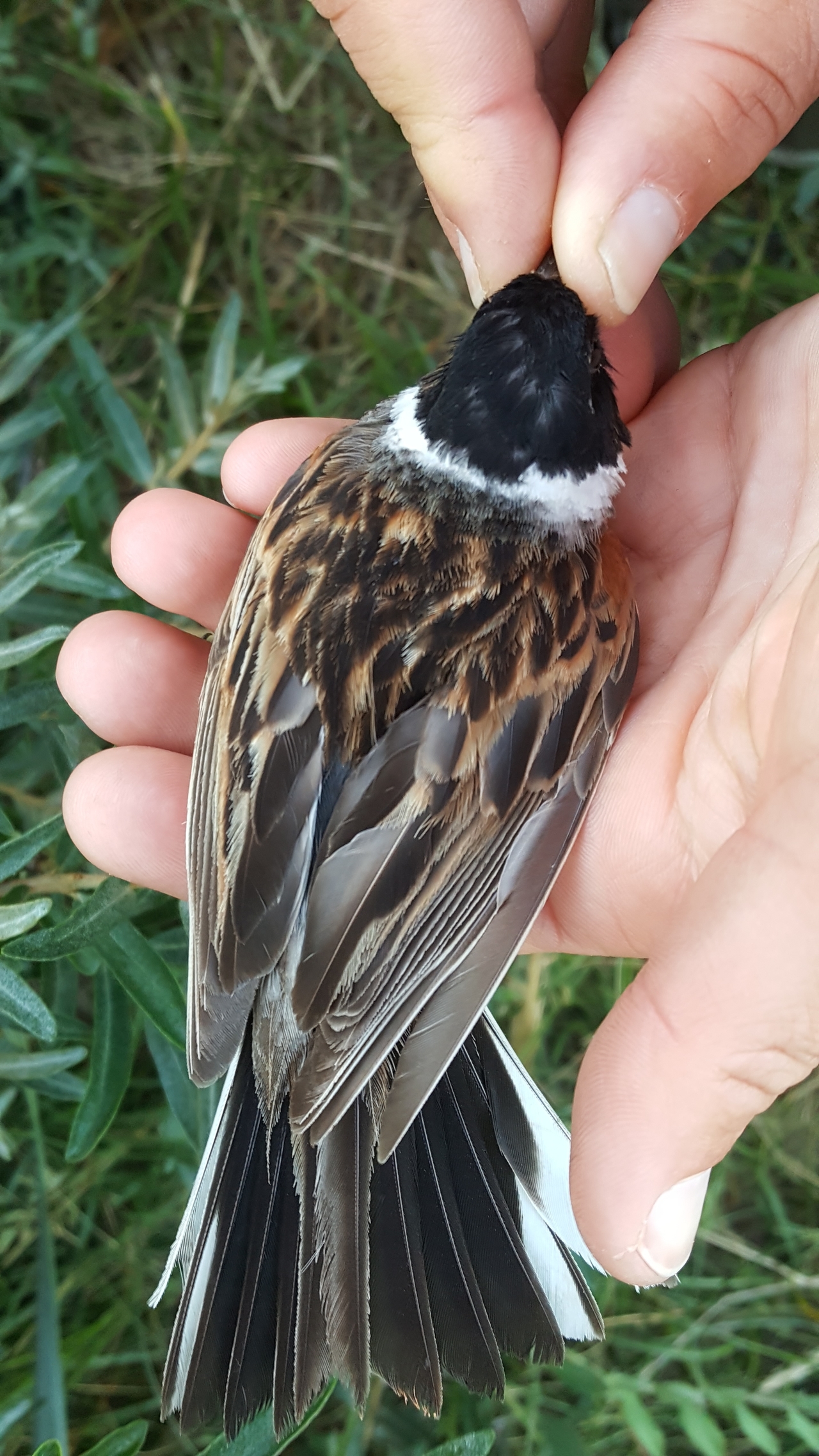
And on our last round, we were lucky and caught a juvenile Grey Wagtail (Bjergvipstjert) !
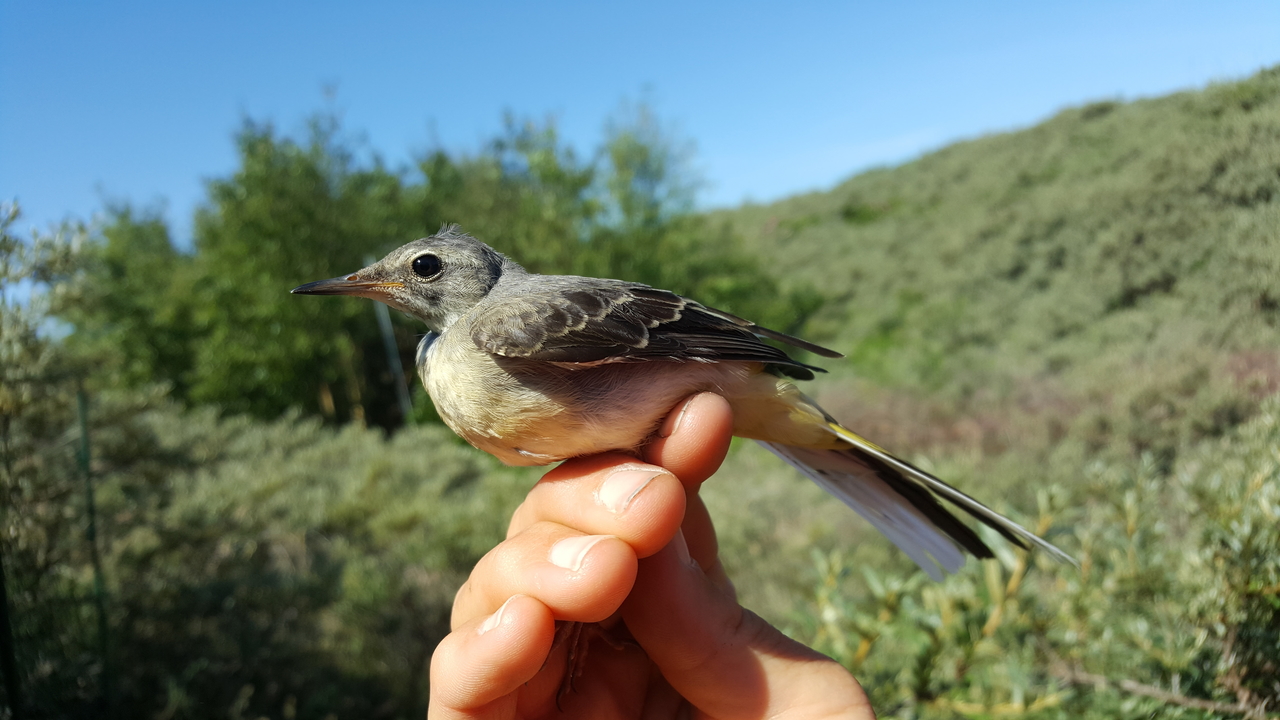
Grey Wagtail (Bjergvipstjert)
We also got juveniles Common Whitethroat (Tornsanger), Great tit (Musvit), Crested tit (Topmejse). Soon we should see some Blackcaps’ (Munk) hatchlings in the nets !
While Martina and I were doing the net checks, Simon and Frederik showed to Pernille’s class how the ringing works via the phone. Frederik ringed a Chiffchaff (Gransanger) in front of the pupils which seemed to be very interested !
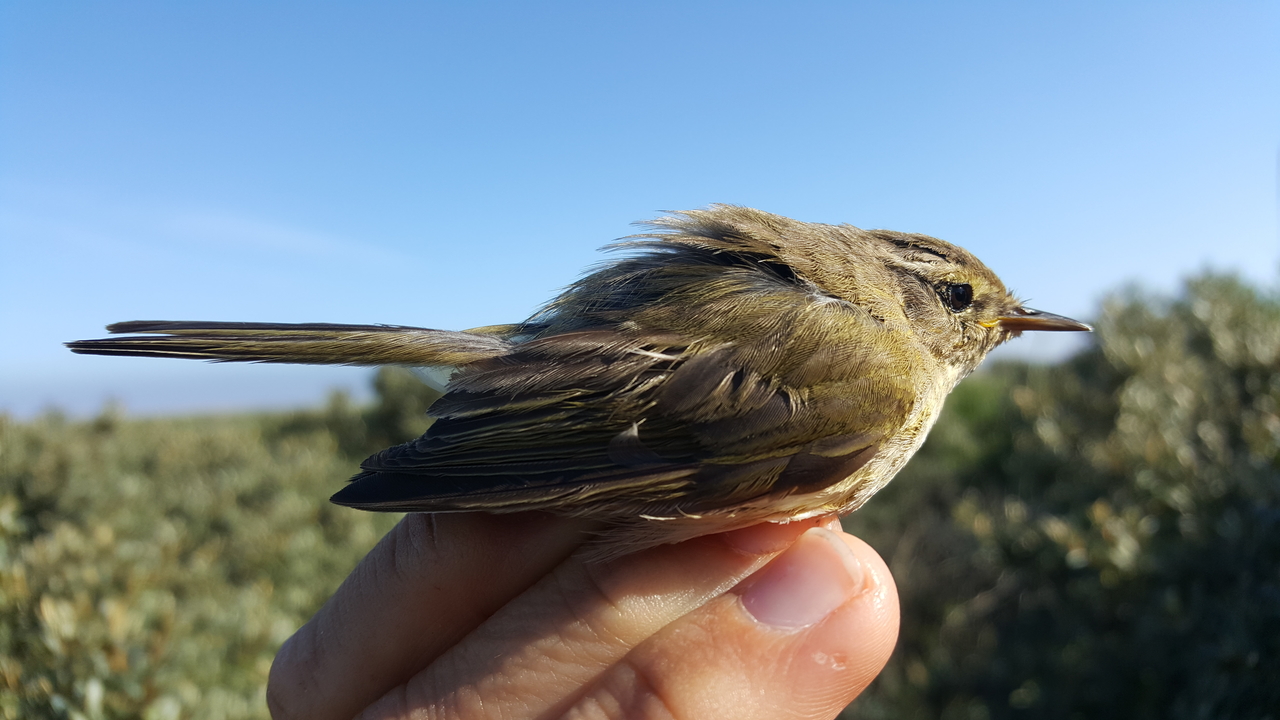 Chiffchaff (Gransanger)
Chiffchaff (Gransanger)
In the afternoon, we set up a trap for moth that we will try overnight. We’re looking forward to see what we catch there tomorrow.
This evening, we are going out trying to catch nightjars with Lars Bo. This should be an exciting night outdoors ! More on this tomorrow in the blog!
Ringmærkning (Kabeltromlen):
Great tit – Musvit – 1
Lesser whitethroat – Gærdesanger – 10
Wren – Gærdesmutte – 1
Marsh warbler – Kærsanger – 2
Reed warbler – Rørsanger – 3
Crested tit – Topmejse – 2
Grey wagtail – Bjergvipstjert – 1
Common whitethroat – Tornsanger – 4
Blackap – Munk – 6
Bullfinch - Dompap, Lille (europaea) – 1
Reed bunting - Rørspurv – 2
Chiffchaff – Gransanger – 4
Total: 38
People : Martina Hillbrand, Amandine Doré, Simon S. Christiansen, Frederik R. Johansen, Pernille Roed
Klik her for at se dagens observationer indtastet i Dofbasen af observatører i området
Klik her for at se opsummeret observationer af rovfugle i Skagen
